#visual prison theory
Explore tagged Tumblr posts
Text
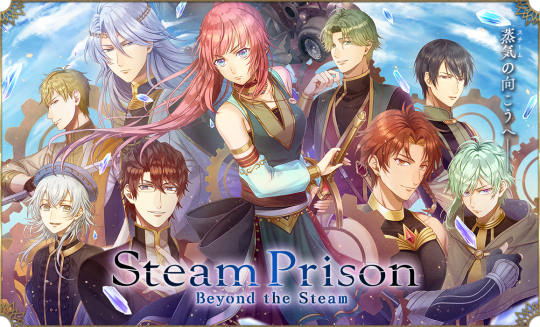




youtube
Steam Prison: Beyond the Steam (スチームプリズン -Beyond the Steam-)
Release date (Windows, Steam, Nintendo Switch) Japanese, English and Chinese: November 28th, 2024
"The Heights are a gorgeous utopia. The Depths, a filthy industrial wasteland. Our heroine, raised in the Heights, has nothing but contempt for those below. Now an observation mission requires her to descend into that world, and the gears of fate have begun to turn.
This story takes place two years after the 'Grand Ending' from the original Steam Prison. While riding the 'buggy' invented by the engineer (and information broker) Ulrik, our party arrives in the new land of Cainabel, where they meet a pair of kings. The story unfolds from there.
The stories of Ulrik, Adage, and Fin take place alongside the younger king Jevite in this strange land. Meanwhile Eltcreed, Ines, and Yune clear the way to Cainabel's future with the elder king Jereme. You can enjoy this episode and its endings from two points of view, depending on which party member the heroine travels with.
This release also includes an additional story titled A New Theory.
In A New Theory, our heroine must confront the injustice of her world. She makes contact with the HOUNDS in order to clear her name, and decides to forge a new path for herself..."
This is the fandisc for Steam Prison! You can buy it from MangaGamer here, from Steam here, or for Nintendo Switch here.
#otome game#otome games#steam prison#steam prison beyond the steam#steam prison a new theory#fandisc#fandisk#gxb#visual novel#voice acting#commercial#hunex#mangagamer
75 notes
·
View notes
Text
The device theory by Molly stars is my lord of the rings.
#GOD ITS SO FUCKING LONG BUT I LOVE IT#the idea of the game being a sort of device to me is completely canon because it works so well and its cool as fuck#very similar to how Oneshot and Off executed the idea of you connecting to a world through a program#but deltarune is going yo take that concept as far as possible i think#darker. yet darker even.#GOD IM SO FUCKING EXCITED FOR THE NEXT CHAPTERS#RAAAAAAH I FUCKING LOVE META NARRATIVES#I LOVE CHARACTERS HAVING THEIR REALITY SHATTER AROUND THEM AND THE DECONSTRUCTION OF VIDEO GAMES AS A CONCEPT#Also the idea of darker yet darker referring to creating fiction within fiction and blurring the lines of reality is so fucking cool#idk but visually it evokes the image of silent hill 2 in the prison when your repeatedly descending down stairs/holes#the idea of going further and further as you lose grip on whats real#also the idea of a character (probs Dess) being stuck in the physical game code is such an awesome idea#watching the community go from “oh hey undertale 2!” to “oh god what the fuck is happening” is fantastic#deltarune just has such an eerie undertone to its story its fucking wonderful#even when its bright and happy the moment you dig deeper it starts becoming genuinely unnerving#sorry i love deltarune#random rambles#deltarune#the device theory
18 notes
·
View notes
Text
GLUE MYSELF SHUT

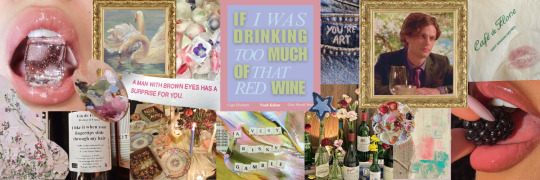

it starts with ice on your tongue and ends with spencer trying not to picture what else his mouth might be good at

pairings: spencer reid x shy!reader warnings: 18+ MDNI, not explicit smut but it's suggestive, post prison spencer, fem reader, fluff, reader has an oral fixation, talk of alcohol, alcohol consumption (wine), spencer having some semi super-naughty thoughts, he’s obsessed with her lips, he’s so down bad it’s not even funny. except it is. i find it hilarious. i feel like the ending was weird but i stared at it for like 6 business days and couldn’t figure out how to fix it so #word wc: 1.6k request: here

The autonomic nervous system, when overengaged, compulsively chases external release valves. Little, repetitive distractions employed to dissipate internal pressure. Cognitive behavior theory identifies these as primitive anxiety-management strategies. Lip-biting, skin-picking, hair-twisting.
For you, the chosen method consists of timed intervals involving ice cubes, precisely fourteen minutes apart. Pinching it between cautious fingertips, rolling it contemplatively, savoring the brief burst of cold against skin.
He watches, a reluctant voyeur to the slow meltwater streams trickling along your fingers in mercury rivulets, until finally disappearing past parted lips. His eyes shutter sideways, hurriedly silencing the part of his brain that longs to quantify the thaw rate versus thermal conduction properties of ice on the surface of your tongue.
You’re studying a painting in the corner of the restaurant — abstract oils bleeding into one another in nebulous fashion behind Emily’s shoulder. Spencer finds himself studying you, an equally abstract form of art. You’re a fan of art. He’s seen your tendency to pause at gallery plaques, eyes tracing curatorial notes while your fingers twitch involuntarily, as though fighting the impulse to physically touch the described textures.
He isn’t much different at this moment.
You’re never exacting, never critical of the things you see. You’re easy to please in the purest sense, content to absorb shapes and colors simply because they exist, acknowledging beautiful things without demanding it prove itself worthy.
It makes him wonder, morbidly, if you’re easy to please in other ways.
Do you make noises when someone kisses you properly? Would your thighs tremble if they whispered how lovely you were, over and over again? Could you come from just a few well-placed touches?
He knows how polymers behave under heat. He wants to know if you’re the same.
He shouldn’t be indulging these thoughts. He’s repeated the admonition several times already, a silent internal chant that does nothing to stem the tide because here you are, unknowingly feeding it.
Your lips gleam with condensation, a lone droplet suspended just above your mouth, a tiny, inadvertent physics demonstration awaiting disruption.
His thumb tingles impulsively, a raw, tactile curiosity urging him to test the exact point at which tension collapses, to feel moisture yield to pressure.
He blinks hard, almost violently, screwing his eyelids shut in an effort to sever the treacherous visual connection tethering him precariously to your mouth. His gaze then drops like ballast to the nearest neutral object — his plate, where a roasted carrot glares back up at him with bland contempt.
Spencer coughs into a closed fist, a pathetic smokescreen for the heat scalding up his throat, licking at his ears like flame-starved oxygen.
With determined resolve, he refocuses, or at least pretends to, zeroing in on Rossi’s dramatic discourse about the fermentation processes and barrel chemistry. Wine science, he assures himself, is safe, dry, deeply unsexy. Unlike you. Unlike the mental imagery of your mouth encircled around other, less work-appropriate things.
These team dinners are, in most cases, a slow bleed. A sensory minefield dressed in linen napkins and over-loud laughter. Spencer doesn’t resent the company, he loves them, every single one, but the sound never stops, the social current too nonlinear to keep up with.
Noise and light and movement pile upon each other until his nervous system blinks seven different shades of red.
So yeah, usually, he counts minutes and builds exit strategies.
But tonight, that never happens. There’s no grit behind his eyes, no anticipatory urge for flight. Instead, there’s only a strange sense of equilibrium and the certainty that it begins and ends with you.
Every shy laugh you offer at Morgan’s jokes, every awkward tuck of your hair behind your ear when attention veers too close to you, every furtive glance his way like you’re reassuring yourself he hasn’t dematerialized between breaths.
He notices it all. Worse, he likes it. Relishes it in a way that feels almost parasitic when he dares to think about it too long.
You inch closer, lowering your voice to be aimed at him. “Do you think Rossi would be crushed if he found out I genuinely can’t taste the difference between this and, like, Welch’s?”
Spencer bites back an immediate grin, angling himself toward you until the barest fraction of space remains between your shoulders.
“I won’t tell if you don’t.”
“So that’s a yes, then?”
“Pretty much.” He slides his glass your way. “Here, try this one. Rossi said it’s supposed to have subtle oak notes. I think that’s just the polite way of saying it doesn’t feel like lighter fluid.”
You accept his glass, fingertips brushing his as you take it.
Spencer’s eyes cling to your mouth as you sip, lips parting over the same place his touched, sealing over it perfectly like you were made to erase him and replace him in one motion.
When you pull back, the wine stains your lips in a dark, sultry crimson. He imagines pressing his mouth to yours until the color smears, until it becomes something new altogether — a hue birthed from shared breaths and synchronized heartbeats. He wonders what saturation your mouth would take on if it were shaped around his name.
Spencer recognizes that he might be one errant breath away from ruin.
There are other people here, he reminds himself. Polite company. His colleagues, no less, who are presumably not here to watch him experience this kind of deranged attention he’s directing toward you. He’s certain he must be blushing, overheating, or having a close, conversational strow. Each scenario feels equally plausible, equally shameful, equally likely to leave him socially incapacitated.
You tilt your head, eyebrows raised in patient confusion. Three long, interminable seconds crawl by before Spencer realizes you’re awaiting a response.
Shit.
“What?” he blurts, louder than intended.
“I said I don’t think I have the palate for this one. Kind of tastes like overpriced raisins.”
Spencer bobs his head eagerly. “Right. Yeah. No, I — agree.”
Your smile is soft but searching as you seem to follow his thought process and come up short. Spencer’s heart kicks harder in his chest. He fumbles for normalcy and overshoots.
“The raisin flavor, it’s probably residual sugar. Or the grape variety, certain grapes naturally have that characteristic. Sometimes they’re intentionally allowed to over ripen, concentrating sugars. Could also be oxidation. Or, possibly, microbial spoilage, though that sounds bad, it’s usually done on purpose, beneficial spoilage. Controlled spoilage.”
“What kind of grapes do they use for that, then?” Your voice is tentative, uncertain, as though worried the question might sound overly simplistic.
It’s not. It’s absolutely fine, ideal, even. Except Spencer’s concentration evaporates instantly when your tongue flicks gently across your lower lip, leaving behind a glossy sheen.
Suddenly, grapes don’t exist. Language doesn’t exist. Spencer himself might barely exist.
“Usually Muscat or Zinfandel,” he manages at last, “They, uh, leave them on the vine longer to intensify sweetness.”
You laugh under your breath, pushing the stem of the glass back toward him. “Makes sense, though I might not be the best judge. My mom used to say that anything that didn’t taste like peach schnapps wasn’t worth the bottle.”
Spencer’s mouth opens, poised to respond, but your hand is already in motion, fingers dipping into your glass for another cube of ice. He watches as your thumb gently glides over its edges. Checking for symmetry, perhaps. You bring it to your mouth and he doesn’t blink, can’t. There’s a fleeting glimpse of pink tongue against transparent ice, the slight hollowing of your cheeks.
All sentence structure evaporates, replaced by a pounding rush of blood to his temples and other less cooperative places.
“That’s…” he rasps, then clears his throat. “That’s funny.”
“What is?”
“Your um. Your mom’s schnapps rule.”
“Oh.” You cock your head. “I always thought it was kinda trashy.”
“It’s not,” he says, too fast. “I’ve heard worse opinions about alcohol.”
“Yeah?” Your purse your lips and the ice shifts, creating a temporary distortion in the shape of your cheek. “Like what?”
Spencer watches the dent smooth out, watches how the overhead lights refract across your skin — warmer along the apple of your cheek, cooler where it softens into shadow near your jaw. A perfect gradient, like a masterwork in motion. A living chiaroscuro. Oil paintings where the subject glows not because of the paint, but because of its depth was coaxed out by patient and loving hands.
He wonders who has painted you in that light.
You mentioned your mother and he wants to know more. What was she like? Did she nurture your curiosity, or did she scold it? Was she tender, or tired? Did she sing while she cooked? Did she let you cry, or did she rush to clean it up?
And your father, was he there? Was he gentle? Did he hug you with both arms, or with silence? Did he make you feel small in the way children should, protected, or in the way they shouldn’t, invisible?
Spencer hopes, deeply, that they were kind. That you were someone’s favorite part of the day. That you grew up held, not just housed.
He doesn’t think you’re seeing anyone romantically. Not seriously. He suspects he’d know, suspects there’d be signs. Someone waiting at the door. A name that surfaces too often.
But you probably have been with people before. Respectful ones, preferably.
“Like how some people can’t tell the difference between a five-hundred-dollar Bordeaux and… grape juice,” he finally says, quirking a brow. “Hypothetically speaking, of course.”
“Not everyone’s tongue works quite as well as yours, Doctor Reid.”
Spencer sees the instant when your brain catches up with your words, cheeks flooding with heat, eyes widening incrementally, mouth parting in a mortified ‘O’.
“I mean — not like that.” You quickly stumble forward, hands fluttering uselessly in your lap, voice pitched high. “Refined taste buds. Taste buds, I meant, not… not tongue in any other context.”
Your expression is a fascinating disaster, eyebrows drawn tight, lips flattened into a line like you’re hoping the pressure alone might rewind time and vacuum every syllable back into your throat.
Meanwhile, Spencer’s imagination flickers to life, promptly supplying him with an intensely distracting scenario involving precisely how well his tongue works when applied directly to you.
“Right. Taste buds,” he echoes, voice two octaves higher than usual. “I knew what you meant.”
Except he hadn’t, not immediately. His heartbeat already sprinting ahead of him, generously pumping oxygen to regions he’d strongly prefer remain switched off. He briefly considers explaining the basis of verbal slips — the Freudian slip theory, perhaps — but decides against it.
Better to pretend that his mind hasn’t already replayed your words more times than strictly necessary.
One day he’ll show you.



shy reader is part of a stand-alone series! you can read more here!
💌 masterlist taglist has been disbanded! if you want to get updates about my writings follow and turn notifications on for my account strictly for reblogging my works! @mariasreblogs
#🌺 maria writes#spencer reid x reader#spencer reid x shy!reader#post prison!spencer reid x reader#spencer reid#spencer reid x fem reader#spencer reid x fem!reader#spencer reid x shy!medialiaison!reader#spencer reid x you#spencer reid x y/n#spencer reid self insert#reid#dr spencer reid#criminal minds fluff#spencer reid fluff
728 notes
·
View notes
Text
It's just so narratively crunchy that Spite writes poetry as his chosen form of self expression. Especially given that he clearly struggles to communicate with the people around him, the fact that he writes poetry in the scant moments he has command of Lucanis's hands really cements other textual indicators that Spite is frustrated by his difficulty with communicating. Over and over again he asks to talk to Rook, to be heard, but when he does get the chance to talk, he isn't understood, which must be unbelievably frustrating for the poor guy. So he practices! In writing! And that writing gives such a neat look into Spite's mind and how he conceptualizes himself and his situation. So I'm gonna dust off my English degree and yell about his poetry.
1.
a PEACE
cut from the ALL
golden stranded weaves
PROTECTION CAGE
keep them OUT
keep me IN
As with all poetry, there's a lot of room to interpretation, and I think that's especially intentional for Spite's worldview as a spirit. He's from the Fade, which operates on perception and emotion instead of concrete immutabilities like the material world. That being said, I think this first poem is Spite trying to process and talk about a.) his own violent summoning from the Fade and b.) Lucanis's mental Ossuary.
Spite was ripped from the Fade against his will, a piece of a larger infinity cut and captured. Likewise, Lucanis creates the Ossuary in his mind as a (poor) coping mechanism for dealing with what happened. Spite recognizes this as an attempt to create peace in emotional turmoil.
The golden stranded weaves evoke the imagery used in the narration explaining how the dagger cuts through the Veil. It's visually represented as gold geometric lines separating the Fade from the material world, which may be a hint to how spirits see the Veil: a barrier made of gold strands that has also stranded Spite from the world he knew. Given that Lucanis's mind Ossuary is also a part of the Fade, this same barrier applies here as well, stranding him and Spite from the freedom they seek.
The Veil and the mental Ossuary therefore function as what Spite calls a "protection cage," designed both to keep its occupants safe and keep them contained. Arguably, Spite could also be talking about the magic that keeps him bonded to Lucanis, magic that is likely similar in nature to how the Veil works given that blood magic is what sustains both. Protecting Spite and Lucanis from being hurt further by the Venatori but also keeping Spite from going home. He's stuck in Lucanis whether he likes it or not. This is further complicated by the mental Ossuary, which Lucanis has unconsciously constructed to keep the people he loves out of harm's way (protecting them) while also keeping Spite trapped.
This is Spite's first cry for help. He recognizes that he is trapped in multiple ways: he is forced to share a body that aggressively does not want to share with him, and the part of the Fade that Lucanis is connected to mentally is also a prison, one that does not respond like Spite would normally expect the Fade to respond. Lucanis mentions in Sea of Blood that "The Fade does whatever a spirit wants. Real walls and chains, not so much," but Spite tells Rook in Inner Demons that he can't touch the locks in Lucanis's mind despite it technically being a part of the Fade. My personal theory is it has something to do with the blood magic that bound them together in the first place, but regardless of why, it's understandably extremely frustrating for Spite to feel trapped both in the material world and the Fade, neither of which respond to him as he expects. To Spite, it must feel like the very laws of physics have stopped working as they should.
2.
scentsing the BEYOND
rememburnings from before
when one was infinity
not a small shade
not a SHARP hooked claw
in a gut
takemeouttakemeoutletmeout
riiiiip
Here we get to see how Spite has been learning to use language to artistically express complex abstract ideas, which speaks to him having mature, adult intelligence, given that abstract thought is a marker of higher-order cognition. In this poem, Spite is no longer simply describing his situation as he is in the first poem, he is self-reflecting and forming his own identity.
It's clear in this first line and in several points throughout the game that Spite's favorite sense is smell, possibly because it is a sense that he can unintrusively access and therefore isn't barred by Lucanis. So he is not just sensing, he is specifically "scentsing" what he calls "the BEYOND," likely the Fade, referencing his ability to pull things from it (especially considering that the little icon on an accessible spot says "a sense of something").
But he's not just talking about the Fade as a place, he's reminiscing of the Fade as a time. But the portmanteau he uses here, "rememburnings" suggests an attempt to explain the emotion he associates with this remembrance. The memory is painful. It burns. It hurts him. He remembers being a part of the Fade, being part of "infinity," and now he is only a "small shade" of what he once was.
But that's not all. He's also demonstrating that he understands how Lucanis perceives him, sees that he is hurting Lucanis. He knows that he was force-fed to Lucanis (quite literally according to his banter with Bellara where he says it happened when "They fed me something. Like he was a parasite in uncooked meat."), which explains why Spite conceptualizes himself as being a foreign, damaging object "in a gut." And, importantly, he doesn't take satisfaction from that. The tone he is using here suggests grief and desperation, especially the "takemeouttakemeoutletmeout." He wants to be free, yes, but he also wants to stop being an object of pain. And yet the last line suggests that Spite knows that separation would also be painful. It would be another ripping, because he is a claw now. As much as he is trapped by Lucanis, he is embedded in him as well, and extraction would tear them both apart.
3.
toes wiggle
when he drinks the brew
a small shade
and a wounded spirit
sitting
there is STILL
we are still
there is an INFINITE
there is a SHELTER
there is a STORM outside the center
UGH Spite your MIND!!! This poem makes me want to cry fr. It's so much more concrete than the other two, showing how he's becoming more familiar and comfortable with Lucanis's body and the material world. The tone is gentle, like a relieved sigh, with none of the urgency and desperation of the others. This is the first time we see Spite describe a physical sense other than smell. He notes that Lucanis wiggles his toes when he drinks his favorite coffee, suggesting that this is something Spite feels as an occupant of the same body, though he likes to manifest himself as separate. It confirms that he feels what Lucanis feels through shared senses, though has his own interpretations of sensory input.
Spite still conceptualizes himself as a "small shade," but no longer is he a "SHARP hooked claw." He is still hurt, still affected by what he and Lucanis went through, but he now sees Lucanis as more than the body he's trapped in. He sees Lucanis as a fellow "wounded spirit," hurting and healing in the same way that he is. They are sitting together, feeling together, and they have found stillness. They've finally made peace.
While he may no longer be a part of the Fade as he once was, Spite has found that being and living with Lucanis is another "INFINITE" that he gets to experience. He is safe, sheltered in their bond. It's no longer a cage. It's just protection now. And while Spite can feel the absolute mess that's going on with the world and the Fade and everything they're dealing with, he is centered now with Lucanis, which makes it all manageable.
All this leads me to believe that after Inner Demons and their little coffee date with Rook, Spite and Lucanis are at a point in their relationship where Lucanis is much more accommodating of Spite and where Spite is able to explore and experience the material world with a certain level of patience. He no longer feels like he has to bully Lucanis into letting him pilot because he understands physical space now and can experience things alongside Lucanis as he experiences them. Lucanis is more confident letting Spite speak through him because he's no longer worried Spite will wrest complete control from him and/or do something to hurt them. As Lucanis says in the final romance scene, they're no longer afraid. Lucanis now trusts Spite's reports about what happened and how much time has passed while he was asleep, which suggests that Spite has earned that trust.
At this point, the line between demon of Spite and spirit of Determination seems extremely blurry at best, and it really makes me wonder if gaining a physical body through means other than normal possession allows spirits to develop more complex cognition and emotional versatility beyond just their purpose.
#I am extremely normal about spite and think about him a normal amount (lying)#He's just so complex and interesting and it Bugs me when he gets reduced to either “little gremlin cat” or “horny foil to lucanis”#My boy did not bust out three beautiful poems for this sort of treatment!!!#dragon age#datv#da4#spite dragon age#lucanis dellamorte#lucanis#spite dellamorte
512 notes
·
View notes
Text
Why did Milsiril adopt Kabru
Milsiril might be one of the most misunderstood characters in dungeon meshi and I see people making assumptions of why she adopted Kabru based only on their races and not in the characterization, so I wanted to think about some of the "theories" I see the most often about what made her take him in and why I don't agree with them
(read more cause as usual I ranted a lot)
1 - Attention (white elf savior)
This is the one I have the hardest time understanding so I'm starting with it, I've seen people compare Milsiril to irl white wealthy women that adopt "exotic" kids to keep an altruistic appearance. Like a white mother adopting a chinese child because of white savior complex and for everyone to compliment them on how good they are but this idea ignores a core aspect of Milsiril: she doesn't like attention of her peers
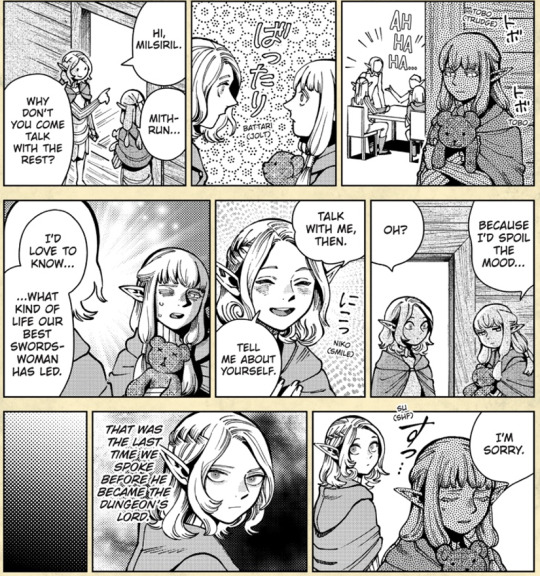
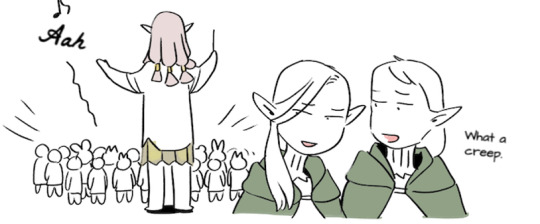
Her bio reads: "The people around her teased her, calling her Gloomy Milsiril; partly as a result, she hates elves. (...) She secluded herself deep in the mountains and intentionally lives apart from other elves"
Milsiril is the type of person that has trauma related to her own kin, she was ostracized by everyone including her own family that sent her to the canaries, and as a result she herself refuses to engage with them even when they extend a hand as you can see with past Mithrun. The only other elf she's seen speaking to is Mithrun when he's sick and Helki. Her interest in raising short lived kids isn't seen as altruistic by other elves it's seen as another weird side of her so there's no incentive in elf society for her to do that. So she didn't adopt Kabru because of optics, she clearly doesn't care what other elves think of her and she hid herself from their judging eyes as soon as she was able to.
2 - She wants to feel superior to someone
Another one I find baffling but I can understand a little better since she's constantly seen in the caretaker role. But the evidence I see for this is literally the type of people she surrounds herself with.
The people we know she interacts with willingly are:
Her adopted short lived children
One of her prisoner partners (Helki)
Mithrun when he's in recovery
Based on these I can see how a very uncharitable view can interpret as "she surrounds herself with people that she's superior to" and it is somewhat true. But she's never shown mistreating or actually acting superior to any of them, if anything Helki is constantly hanging out around her (he was pardoned after Utaya and might be her servant now but their interactions seem very casual), Kabru says she teaches her children everything they want to know and she eventually let him go even if before she was hesitant to (as a overprotective parent) and Mithrun was still a noble with several servants when she cared for him so even if he was sick socially he was still the same. (considering both are noble outcasts)
The evidence both for and against the idea that she adopts children to surround herself with people "inferior" to her are all circumstantial so I guess it depends on how you want to see it. I myself think there's no evidence she thinks of them as inferior considering all we see she seems to treat them either as her babies (would you word your feelings for a baby as them being inferior to you?) or as someone she wants to nurture

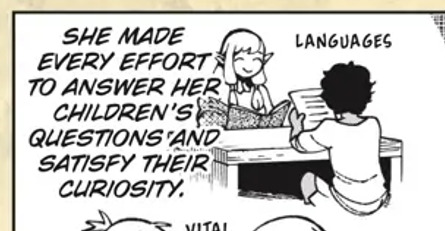
3 - She wants to be in control of someone (Kabru is her doll)
Related to the above reason but slightly different, in this interpretation I see people assume she doesn't see Kabru as his own person but as one of her dolls to be controlled. As if she raises her children so she can play house and dress up with human dolls.
Honestly that's pretty cool and an amazing visual for an evil mom but there's zero evidence that that's the case. Starting with her actual dolls themselves they aren't dress up dolls or something she puppeteers in an evil way, they're literally her comfort toys she runs to when she's sad
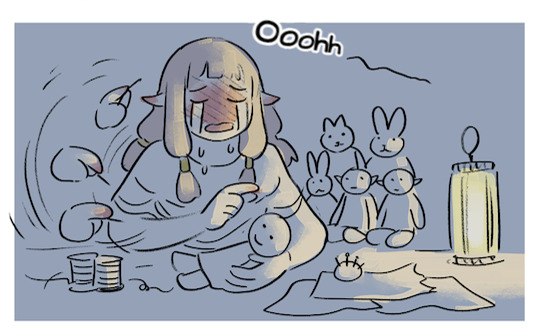
She's making them by hand while crying cause she feels like she doesn't belong, her bio says the dolls are her only friends so it makes me a little sad when people act like her doll hobby is somehow a creepy aspect that makes her seem evil, since that's exactly how the elves think of her (creepy and gloomy)
Milsiril is clearly someone that enjoys taking care of others we see it both with her children and with Mithrun, but how to know if that's actual altruism or some twisted sense of superiority? How to know if she isn't the toxic nurse that just wants to be in power of someone? How to know she is actually helping the people she cares for?
Easy, she helped them until they didn't need her anymore.
She trained Kabru and taught him everything he knows, he's where he is because he had her help even if at first she wanted to prove he wasn't strong enough to go, he was. She sees Kabru as a small child because of their race differences but she still respected him enough to take the training seriously.
Mithrun actually recovered once she could take the time to help him, I keep reminding it but it was years after he was rescued that she went to help with his recovery (his bio says Utaya was what motivated him to finally come back and she was the one that went to tell him about Utaya and help out) right now Mithrun is able to follow a routine and live by himself, Milsiril isn't even someone he talks about as he is now.
Both people we know she cared for are completely independent of her now and neither of them even thinks about her much. A controlling person that wants to keep you within their grasp and keep you needing them would never actually help you be independent of them.
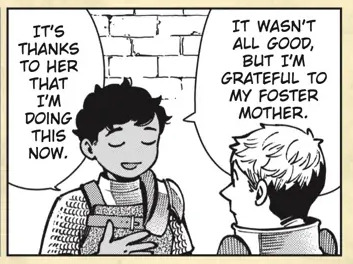

4 - Then why did she adopt Kabru?
I think it's an easy answer the way I see it: shared trauma.
What Kabru went thru is 100 times worse than what Milsiril went thru during Utaya, especially since he was just a small child back then and he lost everything, But Milsiril is still a war veteran, the things Kabru describes, people turning into monsters eating the others, all the death and destruction, Milsiril was there to witness it all and she failed to save them. her bio reads "After the incident in Utaya, she left the Canaries in disgust. She secluded herself deep in the mountains and intentionally lives apart from other elves" she was so traumatized by the events she both left "in disgust" and became a hikikomori. Earlier in her bio it also says "(...) The people around her teased her (...) partly as a result, she hates elves" I sure wonder what's the other part that makes her hate elves. (Probably is the way they dealt with Utaya)
I think she adopted Kabru because she wanted to give a good life to the only survival of the war she fought, the other destiny Kabru could have has would be the same Rin had, a traumatizing stay with the elves, Milsiril saved him from that fate when she adopted him. He wasn't a random brown kid she picked up, they share a traumatizing experience (once again: even if it was 100 times worse for Kabru).
The reason she adopted the other kids is also pretty obvious to me: she likes caring for people and she wants to feel loved. That's her ulterior motive to raise short lived children, she has elf trauma and she wants a family.

That doesn't make her a perfect mom or a perfect person tho*, she's just as flawed as anyone, I feel like people sometimes forget mothers are also human beings with flaws. Being flawed doesn't make her a monster, being loving doesn't make her an angel, she's just a person doing her best.
*She still has the ingrained elf socialization and clearly thinks of her children as babies, she treats teen Kabru almost like a toddler in some interactions. There's also the thing about her not fully understanding the importance of his cultural background. Struggles that I assume are common in interracial adoptions
Disclaimer cause this is the reading comprehension website: This is my interpretation of the character, some of it is very charitable towards Milsiril and I'm not talking about how Kabru might feel about her. I'm trying to think of their relationship thru her perspective and how she treated him because some interpretations seem to come out of nowhere to me. Kabru has complex feelings about elves and about his elf mom but overall I still think "overprotective foster mom" really summarizes his feelings. I don't think he resents her even with her flaws.
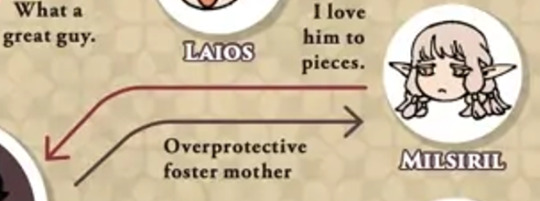
#Milsiril#longpost#dunmeshi thoughts#Kabru#I just saw a joke about her that made me write this whole thing#number one milsiril defender I guess#dungeon meshi spoilers
878 notes
·
View notes
Text
𝓭𝓪𝓻𝓴 𝓪𝓬𝓪𝓭𝓮𝓶𝓲𝓪 ˙⟡🪶─
𝒎𝒐𝒗𝒊𝒆 𝒂𝒏𝒅 𝒕𝒗 𝒔𝒉𝒐𝒘 𝒓𝒆𝒄𝒐𝒎𝒎𝒆𝒏𝒅𝒂𝒕𝒊𝒐𝒏𝒔
Some of my favourite movies and tv shows that I keep rewatching literally all the time, also fit the dark academia aesthetic...
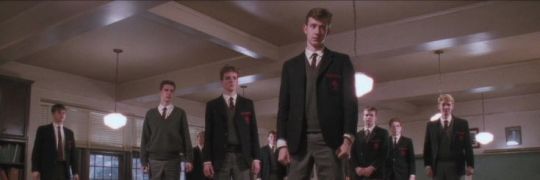
𝒎𝒐𝒗𝒊𝒆𝒔
Dead Poets Society (1989)
A timeless film about the power of literature and the consequences of challenging societal norms in a boarding school.
The Talented Mr. Ripley (1999)
A psychological thriller drenched in luxury, deception, and the pursuit of identity.
Kill Your Darlings (2013)
Follows young Allen Ginsberg and his entanglement in a murder during his time at Columbia University.
Atonement (2007)
A visually stunning film about love, betrayal, and regret, with an air of intellectual melancholy.
The Imitation Game (2014)
A story of genius and tragedy, focusing on Alan Turing’s work during WWII.
The Riot Club (2014)
A dark examination of privilege and elitism among Oxford students in a secret society.
Harry Potter Series (2001-2011)
Especially The Prisoner of Azkaban, which captures the darker, atmospheric tones of the series.
Crimson Peak (2015)
A Gothic romance with haunting visuals and themes of mystery and intellect.
The Oxford Murders (2008)
A mystery set at Oxford University, blending logic, philosophy, and crime-solving.
The Theory of EVerything (2014)
A poignant biopic about Stephen Hawking’s life, featuring beautiful academic settings.

𝒕𝒗 𝒔𝒆𝒓𝒊𝒆𝒔
The Umbrella Academy (2019-2024)
While more fantastical, its themes of family, ambition, and intellectualism align with dark academia. (we're going to act as if the 4th season never happened)
Sherlock (2010-2017)
A modern take on Arthur Conan Doyle’s detective stories, with a focus on intellect and mystery.
The Queen’s Gambit (2020)
A visually stunning series about genius, competition, and the pressures of academia-like environments.
Penny Dreadful (2014-2016)
A Gothic series weaving together classic literary characters with dark, intellectual themes.
How to Get Away with Murder (2014-2020)
A thrilling blend of academia and crime, revolving around law students entangled in murder mysteries.
Derry Girls (2018-2022)
Though comedic, the show captures an academic setting with themes of friendship and youthful rebellion.
The Magicians (2015-2020)
A fantasy series with a dark academia feel, featuring a secret university for magic and complex moral questions.
His Dark Materials (2019-2022)
A richly intellectual fantasy series set in an alternate, academic-focused world.
Gilmore Girls (2000-2007)
While lighter, it captures the love of books, academia, and witty intellectual banter.
Shadow and Bone (2021-)
A mix of dark fantasy and the kind of rich world-building that appeals to dark academia enthusiasts.

Let me know your favourite movies and/or tv shows that I should watch.
-michala♡
#dark academia#dark academia aesthetic#dark academia vibes#dark academia moodboard#dark academia movies#movie recommendations#must watch#movies and tv shows#dark academia tv shows#books and libraries#bbc sherlock#dead poets society#shadow and bone#kill your darlings#tv show recommendations
158 notes
·
View notes
Text
Thou Shalt Not Kill - Chapter 14

AU Noah Sebastian x female detective reader
18+
Summary: Reader is a detective and is assigned to a murder case which she soon connects with previous killings and figures out the religious affiliation, proving there is a new serial killer within the city. Reader soon becomes obsessed with the killers mind and methods and won’t rest until she figures out who the killer is. All while she gets used to working with her new partner on the case, detective Noah
Warnings: graphic writings of murder/killings, blood, gore, violence, serial killer, swearing, god complex, use of religion, obsession, dark romance, stockholm syndrome, non sexual shower scene, I’m pretty certain that’s it but please let me know if I’ve missed anything!
Another chapter done, we are getting very close to the end now, how’s everyone feeling about that? I’d love to hear all your thoughts and theories for the end 🖤
Story Taglist: @Iacy1986 @hayleylatour @calleyx13 @english-fucker @malerieee @ithoughtbynowidfeelbetter @softvgold @lilhobgobbler @glccmreid @badomensls @madomens @loeytuan98 @iluvmewwwww75 @rosebushjhj @livingdeceasedgirl @lilrubles @samanthasgone @blackveilomens @hellayeahsword @lookwhatitcost @doomhands-jr @nojoyontheburn @poisongirl616 @bakanerd @sacredthefran @flowery-mess @fadingangelwisp @theanarchymuse95 @1toreyouapart @xxkatsatwatwafflexx @overmydeadbodysblog @concretejunglefm @sister-sebastian @alwaysfightforwhoyouare @fenixyrie @astronoids @ami—gami @bloody-spades
Let me know if you wish to be added!
Chapter Index Here
Masterlist

You woke the next morning, body heavy and sore and yet somehow blissfully peaceful.
You opened your eyes to see sunlight shining through the little window and illuminating the room around you.
It was then that the events of the night before suddenly came rushing back into your mind.
The sex, the blood, the murder.
You looked over to the corner of the room to see no body, just dark, dried bloodstains smeared across the concrete.
You sat up and held the sheets to your bare body, feeling how deliciously achy you were. You glanced down at your hands and arms to see blood still there, a visual reminder of your sins.
You should have felt guilt, shock, upset.
But nothing. You felt nothing.
“It’s been dealt with”
You jumped slightly and looked over to the open door to see Noah stood there leaning against the door frame with his arms folded and a small smirk across his lips.
“Wha…how?”
Noah chuckled and walked over towards the bed and sat down next to you.
“You were passed out angel, so I took care of it. You don’t need to know anymore than that”
You went to ask another question but you stayed quiet, you knew he wouldn’t tell you even if you asked and he was right, probably for the best that you didn’t know.
Noah reached his hand up and brushed some of your hair behind your ear.
“You looked so beautiful last night, you completely surrendered. Even god himself would have cowered in fear from you”
Noah glanced down at the stains over your skin.
“Come with me”
You stared at him confused.
“I said come with me angel, we should get you cleaned up”
You watched as he stood and walked towards the main door, you glanced over at the small bathroom area that you’d been using all this time.
“Upstairs detective, you don’t need to be down here any longer”
Your heart leapt at the thought of being free of these four walls, although Noah had made your stay here as comfortable as possible, this was still your prison.
You reached over and grabbed your night gown that was hanging off the dresser next to you, stood and wrapped it around your frame.
You felt almost nervous.
Was Noah really going to let you leave this place?
You tentatively took a few steps, the ground cold against your feet as you made your way over to him as he waited in the doorway.
You took a breath and went to walk on the stairs when…
*smack*
Noah’s hand slammed into the wall next to your head, his arm blocking your path as he leaned over you.
“Now I’m trusting you angel, you will be freed from this basement, you’ll be able to go anywhere in the house as you please, but….”
His voice turned cold as he removed his hand from the wall and grabbed you by the back of your neck. Not painful, but firm.
“Don’t do anything….stupid. I’m giving you some trust here baby. Don’t make me regret it. You may not be a prisoner down here anymore but that doesn’t mean I’ll just let you walk free. Understand?”
His thumb traces over your cheek almost lovingly as he stared down at you.
You nodded and grabbed his hand.
“I’m not going to run”
Noah smiled and then moved to the side to allow you to walk up the stairs.
You walked up the dark stairway and saw another door had been left ajar, your fingers reached for the handle. You hesitated, as if Noah was about to laugh and say it was all a cruel joke, but instead you felt his hand press gently into your lower back, guiding you through.
You walked out into a decent sized, modern styled kitchen.
Dark countertops, matte black cabinets. Everything in its place. No clutter, no dishes, not even a smudge of food or old soap on the draining board. The kind of kitchen that didn’t feel used, just…displayed.
It wasn’t cold exactly. Just clean. Neutral. Like a hotel suite that you could abandon at any given moment.
To the right an open doorway led into a living space, you glanced over the dark leather couch, low glass coffee table, books stacked in clean towers, not a cushion out of place and hardly any personal touches had been made to the room.
Noah’s hand guided you forward again, wordlessly, down the hallway that was bare of family photos but did have one or two paintings breaking up the white paint.
Noah stopped you in front of another door and he opened for you to reveal his bathroom.
Again it was modern in style, but vacant of any real decor making it look more like a show room instead of somewhere that’s lived in, although you did see a couple of his products on the shelf in the shower showing that he did in fact use this space.
You took a step in and finally casted your eyes up to the big mirror above the sink and was almost taken back by your reflection.
You stepped forward as if in a trance as you took in your appearance.
Blood was splattered onto your cheeks and temple, there was a bloody hand print covering the light bruising that had formed on your neck, your hair was a tangled mess, dark circles surrounded your eyes and your skin appeared paler than usual.
You gripped the sink and once again saw blood, it covered your hands, went up your arms and you felt it under your nails.
You didn’t feel discomfort over it as such, just hollow, like a shell of what’s left.
You heard the sound of running water and then felt Noah’s presence behind you. He kissed the side of your head as he undone the ties to your gown and he it let it fall to the ground in a silent heap.
“Come on”
His voice was gentle, it was almost overwhelming how his moods could change depending on the situation.
You allowed him to guide you over to the shower, the room was already filling with hot steam.
You stepped into the shower and sighed as the hot water cascaded over your body, the water on the ground turning red as it circled down the drain.
You felt Noah step in behind you, the feeling of his broad frame feeling like an anchor as you leant back into him, his arms wrapped around you like a cage, blocking everything else around you out.
You closed your eyes and enjoyed the feeling of your muscles relaxing in the heat.
“Let me clean you up angel”
And you did.
Noah picked up a clean wash cloth and soap and started to wash and rinse your body, washing away your sins.
It felt incredibly intimate, not sexual but almost soft. No words were spoken. He just moved with quiet precision, first your shoulders, then your back, then over your chest and down your arms. His touch was gentle, like he wasn’t just cleaning you…he was purifying you.
You felt his fingers pause at your wrists, where blood had dried in the creases. He lingered there for a moment longer than necessary, tracing slow circles with the cloth like he wanted to admire the stains before they were washed away.
You didn’t flinch. You didn’t speak.
You just let him.
As you watched his hands move, you then noticed the red nail marks in his arms, breaking up the ink in his skin. Your mind was then taken back to last night as you held onto his arms as he’d held onto you.
You then looked at his face, he was calm, so calm as if this was an every day occurrence, totally normal. But there was something else in his eyes, something so tender that it almost frightened you.
Once the blood had been completely washed off, Noah then moved to wash your hair, being careful to try and untangle the knots with his fingers before he used the shampoo and conditioner and massage them into your scalp.
You couldn’t help but let out a small groan of satisfaction as your head tilted back into his hands and you felt a low chuckle vibrate against your back.
“There we go”
You opened your eyes and turned around so you were staring up at him.
“Thank you”
Noah gave you a small smile, for a moment it was like old times, like none of the horrors were real. The way he looked at you had you wondering, and you couldn’t stop the question falling from your lips.
“What do you feel for me?”
Noah titled his head slightly at your question as you felt your stomach twist in knots waiting for his response. You knew your feelings for him, you had known for a long time, no matter how hard you’d tried to fight it.
Noah brushed some of your wet hair off your shoulder and let his fingers trace your skin absentmindedly before he leant down and pressed his lips against yours softly and then pulled back slightly so he could look you in the eyes.
“I would kill god for you angel, and then I’d use his bones to carve you a throne”
You felt your chest tighten.
“So…you love me?”
“Better, I worship you”
You didn’t speak after that, there was nothing left to say, you knew.
The steam wrapped around you like a veil as he reached for the water, turning it off with a soft click. Noah stepped out first, grabbing a towel from the rail. He wrapped it around you gently before grabbing his own. He pressed a kiss to your temple as you leaned into him with a small smile.
“Come on detective, let’s get you dressed”

The next day you were sat in his kitchen, the rest of yesterday had been like a dream, nothing much happened apart from you learning the lay out of his place and following him around.
You sipped on your coffee, still trying to adjust to being free of the basement, Noah had bought your belongings upstairs and said you were free to place them wherever you liked today.
You heard the sound of the front door unlocking, because of course Noah wouldn’t leave it unlocked if he was out, and you heard his footsteps as he approached the kitchen.
You looked up and saw his tall frame come into view, his clothing a lot more casual today than you were used to seeing him wear and he had a newspaper tucked under his arm.
Noah didn’t say anything, he simply slid the paper across the table so it was in front of you.
NEWSPAPER HEADLINE
“Body Found Outside Courthouse in Apparent Staged Killing”
Photo under the headline only shows police tape and a tent erected outside the courthouse with offices standing on scene.
You put your cup down on the table and picked up the paper, unfolding it so you could read the article.
Victim identified as Ethan Collins, previously acquitted in high-profile cop killing case
Authorities have confirmed that a body discovered outside the downtown courthouse in the early hours of the morning belongs to 53 year old Ethan Collins, a man previously acquitted in the unsolved murder of an LAPD lieutenant 11 years ago.
The scene, which investigators have described as “symbolic” and “highly disturbing” has sparked immediate speculation about a possible connection to the Ten Commandments Killer, whose string of murders abruptly halted nearly two months ago.
Law enforcement has not released further details. The case is currently under investigation. Police have urged the public not to speculate and to report any relevant information to the local authorities.
You glanced up at Noah who was now drinking from his own cup with a small smirk.
“Told you I’d taken care of it”
You put the paper down and pushed your cup away, no longer in the mood.
“By placing the body at the courthouse?”
Noah shrugged casually.
“It sends a message, to the police it’s the 9th murder but you and I both know the commandments are done, it ended with me and you. The world will see my vision soon enough”
You frowned slightly.
“What do you mean?”
Noah leant forward on the table, his eyes boring into yours.
“It means that no matter what angel, my work will be completed. You can stay here with me. ‘Thou Shalt Not Kill’ and ‘Thou Shalt Have No Other Gods Before Me’….but those roles can easily be reversed”
He sat back in his chair with a sinister smile.
“I can’t just let you go free now can I? Stay with me angel, let me be your god”
You took a breath as his words weighed heavily on you, before you looked up to met his gaze.
“I’ll stay”
Bonus Chapter
#thou shalt not kill#noah sebastian#bad omens#bad omens band#bad omens cult#noah sebastian davis#noah sebastian x reader#noah sebastian fanfiction#noah sebastian imagine#noahsebastian#noah bad omens#noah sebastian drabble#noah sebastian smut#noah sebastian fic#concreteangel92
60 notes
·
View notes
Text
weighing in on the mythal design discussion, in response to @broodwoof's two posts here and here, and @idontevenlikedragonage's post here
as has already been said, i also 100% believe the design choice was deliberate. it's very obvious that the dev team put a lot of thought into the designs of everything in this game, it is visually stunning and contains so much unique design for environments, characters, cultures, factions etc. if i had the link to the post about neve & dorian's colour palette and how it contrasts the venatori handy, i'd link that too. (edit: @haedia sent me the colour theory post!!) everything in this game is purposeful and meaningful.
so with mythal, the design makes complete sense to me based on how i've interpreted her character, and i believe the devs put plenty of thought into it. lord do i know that there are many people who didn't interpret mythal the same way as i did, even among the people who like her, so i can see how some expected "more", but for the character i see mythal as, the design is perfect.
as i see it:
again, as others have said, mythal is not truly a goddess. none of the evanuris are gods. solas isn't a god. solas actively chafes against being called a god. they're spirits who took mortal form and became powerful leaders; being gods was a narrative, not reality, and then a dalish legend
mythal wanted to be a ruler, yes, but not for power. she wanted to be a ruler so that she could guide the elvhen. she doesn't care about being above others, she cares about protecting others
crossroads mythal is a single fragment of who she once was
crossroads mythal has been there alone, observing, for millennia
mythal is intimidating in how she carries herself and how she speaks, she is testing you and assessing you the entire time you're talking to her. regardless of how she looks, her writing and framing is plenty formidable
for an even more in-depth post about how i view crossroads mythal, i have a meta piece here.
so this adds up to a person who doesn't see herself as grander than others, who is secure in her own power, and therefore does not need to perform in order to signal how significant she is. if you see her and think she looks basic so you treat her without the respect she demands, you're going to pay the price for that, violently. when you're talking to mythal, she's getting the measure of what kind of person rook is. she's deciding if rook is worthy of wielding her power, and she favours a rook who cares about doing right. you can't sway mythal by sucking up to her, you need to prove that you're fighting this battle for the right reasons. mythal herself is not looking for grandstanding, she's looking for a real person who cares. the mere image of power or greatness is nothing. what matters is what's beneath the surface.
she isn't a goddess. she knows that. she isn't pretending to be. she isn't interested in feeding her own ego and lording over everyone like elgar'nan is. she isn't striving to be anything more than she is, like ghilan'nain does. she is just herself and she lets her aura speak for itself. in my opinion, this comes across as way more powerful than elgar'nan's larger-than-life design or even flemythal's HBIC design. i could go on another tangent about flemythal's choice to dress the way she does in da2 on, but this is about crossroads mythal. i'm forcing myself to focus.
crossroads mythal also has no one to impress, even if she felt the need to impress anyone, which she doesn't. she is alone. solas hasn't visited her and she's bitter about it. this is mythal when she's alone, just herself. rook and their companions might be the first people she has seen in the flesh in an untold number of years.
and she's merely a fragment. she is the part of mythal who was betrayed and killed. she's hurt, angry, bitter--hopeless, disconnected, caught in a liminal space. her refuge might as well be a prison. emotionally, she's not going to be interested in presenting herself in a grand, magnificent way--she's caught up with internal turmoil. then, if her rage wins out during the conversation with rook, she turns into her dragon form, which is plenty grand, magnificent, and dangerous. if she chooses to unleash the full brunt of her power, this is when she becomes visually formidable. a powerful design doesn't have to be specifically/only her elvhen form. this is mythal when she feels the time has come to show her full power.
(and if you do convince her, then this moment happens later while fighting the blighted dragon. she swoops in with a bomb-ass one liner and wrecks shit at a moment when rook and their companions are realizing just how much shit they've gotten into. in my first playthrough, i was somewhere around 15 levels too low for this fight and she saved my ass. i truly couldn't have done it without her)
when i first walked down that snowy path to mythal, i was struck by the intensity of the moment. you can see the fade's endless sky beyond her. you can see the massive arena where she'll try to kill you, if you disappoint her. everything is white, covered in snow--it's blinding, it's unsettling. and mythal--just one person, albeit an ancient and powerful one, but not a goddess--is small in the distance compared to the rest of the tableau. but she's standing there, right in the center, waiting for you. she knows who you are. she's expecting you. there is nowhere to go except directly to her. she's the source of gravity in this empty place, and you must approach her. your companions will always comment with statements that are a mix of uncertainty, wariness, and even awe. and when you greet her, she says, "you know who i am." because of course you do. you're here for her. it doesn't matter how she looks, the framing of the entire encounter is oozing intensity. if you've taken in all the information the game has provided about her until this point, you know exactly how formidable she is.
i felt intimidated the first time i navigated that conversation. morrigan's advice was constantly in the back of my mind. respect, but don't pity. prove yourself. she's prickly. she can and will kill you. i was immersed in the game, and therefore i was nervous. mythal didn't need to be dressed in a larger-than-life way for me to feel that way. i think the design of mythal, the crossroads, and the scene framing was all on fucking point to make that moment significant, exactly as it was. and i love it! that conversation is one of my favourite parts of the game. i wouldn't change a thing.
#mythal#mythal positive#dragon age#davg#da meta#my meta#hope the tags/links are okay ;w; wanted to showcase yall. love this topic love the posts about it#back at it again incapable of shutting up about mythal 😎
67 notes
·
View notes
Text
Beth was a great Character, you're just misogynistic
Sorry for the title, just want ya'll to read this.
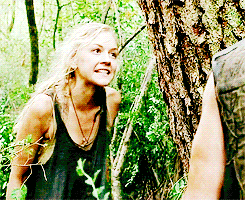
TW: mention of, SA, violence, abuse,
Why Beth is an amazing character and could have been even better:
Female experience in the Apocalypse:
We don't focus enough on it, especially in The Walking Dead. We got hints throughout the show. For example the issue with Lori and Birth specifically the talk about her losing the baby with Hershel.
Second Maggie's experience with the Governor. And even though that storyline was well executed to a certain degree. We do not get the full ramifications after her conflict with Glenn was resolved. Yes once more the Female Experience was focused on the man not the woman. Even though the show called Glenn out on his behaviour, it still was about a man feeling angry instead of a woman going through something traumatic.
So, Beth's experience would have been important going forward. Since she did experience attempted rape. How would she react to people in charge like someone aggressive, loud, outspoken, and unpredictable like Dawn and Gorman?
How would she take Abraham's unpredictability and outspokenness? How would she deal with the socially inappropriate comments Eugene makes?
(Again this is not about the men and “oh but they wouldn't do anything” or he is “harmless” etc.) This is about a trauma response.
So what trauma did Beth experience?
Firstly she was taken against her will, most likely forcefully in some way (her arm was broken). Her agency was taken, her free will, and the (somewhat) security of her surroundings, mainly her family member Daryl who she knows she can trust.
So she is kidnapped, put in an unfamiliar environment, unfamiliar people, and she has no idea how to navigate such a situation since she has never been in this situation. The situation mainly being, can she trust them? Can she trust what they are saying? Who are these people? How does it work here and what are their intentions?
The disorientation she must have felt waking up in that environment must have been traumatic. We see with the camera work if we look at Beth's timeline. Her last words are "I’m not leaving you”. Cut to the car speeding away, cut to Beth waking up in an unfamiliar place. These cuts are very abrupt, confusing, and scary. It serves the purpose of confusing the viewer. (What happened to Beth? I think Daryl put it best “she was just gone") and it makes the viewer anxious, nervous, and the need to know what is going on. So we can imagine that Beth feels these things too.
Furthermore, the show makes a point to show that the world is not what it used to be. I mean the Team Family lived in a prison after all. So having Beth wake up visually in a clean room. Her face clean, her hair brushed out nicely, and professional medical care is like a break from the (her true) reality Beth lived in. Another point is the music and the way she wakes up. It is almost like a dream sequence. Like she had just been in an accident, but all is well now since she is in the hospital. Almost like a sleeping beauty type of deal (but modernized).
To sum up, her first Trauma is the shift of reality, specifically of her surroundings. The funeral home was not safe, it was a trap. She is no longer with family, but her agency, which she had to a certain point (cannot control things like walkers, or people attacking their home) is taken completely away. Lastly, the new surroundings differ from what she knows from the outside. It is like back at the farm “we were fooling ourselves into thinking we were safe” and “you don't know what it is like out there,” but Beth does know now. And even though Grady likes to pretend that the outside world did not touch the hospital, it did. Maybe not in the sense of walkers, people looting the place, dirt everywhere, but the mentality presented to us, the question of “Survival of the Fittest” is present in Grady. We see this theory of survival of the fittest through the first 4 seasons, but not in this scenario where people deliberately want the weak to enslave them and claim it is saving them.
Where do we see Survival of the Fittest?
Randall and Dale
Is this a world for kids?
Disability: Hershel losing his leg
The Governor and the way he manipulates the “weak” residents of Woodberry and takes out the “fittest” f.ex. the military guys.
Does sickness discrimination against the weak and the strong? (The flu storyline)
So now we have Beth's storyline mixed with the question survival of the fittest. Beth is constantly underestimated and Dawn constantly says/tries to show that Beth is not strong. I don't want to focus on how this can be used to your advantage but the mental tool it can take on you. This is a form of demeaning people, keeping them in “their place”. It fucks with your head when things in your past (suicide scar) is used against you, your appearance (Beth is skinny, with big blue eyes and generally deemed innocent and non threatening looking). She outright says “I am strong” but no one believes her. Which is a form of silencing therefore further taking her agency away from her. At one point does Beth start to believe this? would it take months or years for this kind of gaslighting to have an effect? This can be compared to Daryl’s inner monologue in Season 2 when Merle tells him “no one is ever going to love you but me little brother” which we can guess as viewers is something he was told/taught for years and Daryl believed it.
Now this could have been interesting to see in Alexandria. Before everything happened with the fall of the Farm and the Barn incident. (Even to an extent the prison era) Beth would have fit in perfectly in Alexandrias society. The sweet farmer's daughter who takes care of a child that is not hers, helps out with chores, sings, reads the Bible, and hopes for summer picnics and birthdays (which in no way is a bad thing, I love that side of Beth!). Now she has encountered Grady, a place that was from the appearance like the old world and Beth was believed to fit in - so is Alexandria. How does she handle the constant shift of what she's supposed to believe the world is? Is it like Grady? The road from Atlanta to D.C.? Or is it like Alexandria? Could it be like all three or could Alexandria be just another “false” hope?
To sum up, the Trauma of being taken out of one surrounding and what you believe the world is like and being put in another with different rules and she has no idea how to navigate them since she does not know them and does not have any protection from her family being there. (Grady's system of running things is so vastly different from the Prison, also let's call Grady's system what it is: Slavery. They kidnap people and make them work “work of what you owe and then you can leave” “I haven't seen it work like that”)
Now to the people: Beth has experienced different kinds of traumas with the people in Grady.
Gaslighting (“you were alone, we saved you, you owe us, you are not strong,...”)
Physical abuse (Dawn hitting her, her scars on her face, bruising, a cast on her arm)
Mental abuse (the doctor making her kill someone and then claiming she messed up (also falls into the category of gaslighting, having to rely on the same doctor to not get SAd by Gorman))
Sexual abuse (that is mostly the female experience. He is in charge therefore in a position of power, he is older, and she is just a weak young woman) the abuse was: the fear of it happening, the lollipop incident (yes that is a traumatic event), the constant watching from Gorman, how trivialize it is by the police officers “laughed about the poor girl getting raped”, the top person in charge does nothing to stop it (“ you know what is happening here and you let it happen”), and then the SA in Dawn's office)
How is it that we never get to see this female struggle? This (more often) female fear and trauma? Michonne and Andrea traveled alone, but this fear never comes up. We have one mention of an incident where Randell tells the story of the two teenage girls. But honestly my biggest fear in this world would be traveling alone as a woman and encountering men. It is already bad nowadays. Can you imagine this in an Apocalypse?
So why do we ignore this very real fear women face? Why do we kill the one character who actually has a storyline, who focuses on this female fear and female trauma, without any connection to a man or the typical motherhood storyline TWD does?
Why not show that this was ACTUALLY traumatic. Since we even see Beth smile at Dawn after getting SA, killing him, and then leaving the office to go escape? I am glad Beth could put on a smile so Dawn wouldn't know but why do we never see Beth scared, look around her, keep an eye on the door while she sleeps, even trying to lock the door in some way so no one can get in while she sleeps. Why do we not see a far away look when she is trying to first process what happened. There are soo many trauma responses, and everyone is valid in the way they respond to trauma. So why do we not take trauma into account in female storyline? This is my biggest issue with TWD. Lori got one scene of her crying after Shane SAd her and then it was back to the love triangle (which is absolutely disgusting). Why did Rosita not get to be angry with Eugene like Abraham? There are so many storylines even when the woman is involved that focuses on the male response instead.
Let Beth be human, with human responses and more than just another dead girl. Show me how she would cope with her personal space being violated, the perception of personhood being breached. Could she react aggressively when Eugene makes a socially inappropriate comment. Would she be tense, nervous, keep an eye out for him? How about Abraham's imposing statue? What about men in Alexandria? Could she struggle socializing with men? Keeping to the people she knows and clinging to the safety they once represented to her like Glenn, Rick, Carl and Daryl. They are the men that never did anything to her. Or could she even pull away there and struggle to come to terms that they are safe but also men. And men had not been safe for women in Grady.
How could Beth respond to Deanna knowing how Dawn presented herself. Would she be uneasy? Would she be able to tell that Deanna is not like Dawn since she knows the signs of a bad leader because of Dawn.
I am just mad how we ignore this big (and unique to TWD) storyline of a young woman witnessing her father get beheaded, her home destroyed, her relationship with Daryl, her kidnapping, enslavement, physical/mental/sexual abuse? All that just to further other people's storylines for a couple of episodes just to forget about Beth after that.
What do you think? Comment below
64 notes
·
View notes
Text
Season 3 -Surrealism and its psychoanalysis of Carmy Berzatto
Stick with me here if you like. I'm here to talk about how this season it dove into a psychoanalysis and surrealist style cinema on Carmy and his sexual urges. @currymanganese @caiusmarciuscoriolanus & @vacationship discussed in another thread the surrealism of this season with its close shots and quick cuts as well as leaning into faint storytelling and a focus on moving images. Surrealist Cinema connects with Sigmund Freud's principles in creating this film style.

Surrealist films are connected to Sigmund Freud's ideas about dreams and the unconscious mind. These filmmakers used strange, unexpected scenes and bizarre images to depict what’s going on deep in our minds, creating movies that feel like crazy, vivid dreams. The Surrealists ran with this idea in their art to capture pure thoughts from the unconscious mind.
Freud's ideas are super handy for understanding Surrealist art. Early on, Freud figured out that dreams are like visual poems, using metaphors to show our unconscious thoughts and desires. But our minds censor these dreams, turning the original thoughts into metaphors through something called displacement and condensation.
The filming this season prioritized mood over storytelling, which is another interesting aspect. It also featured a surrealistic style of non-linear moving images like in Episode 3x01 Tomorrow- non linear in Carmy's unconscious stream of thought. This symbolism also shown through the displacement of scenes and images.
What is Displacement?
Freud thought Displacement was the important part of dream work, and surrealist felt this way with film. It swaps out objects or concepts with symbols to hide the real meaning. Surrealist filmmakers committed to this act of symbolism. Symbolism is a figure of speech of a character's actions, words, and events that has a deeper meaning.
One example of symbolism from Freud defines that knives often symbolize male genitalia and boxes symbolize female genitalia in dreams.
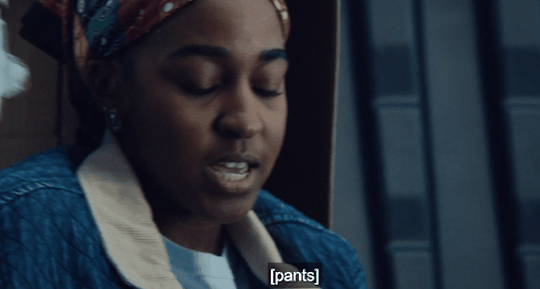
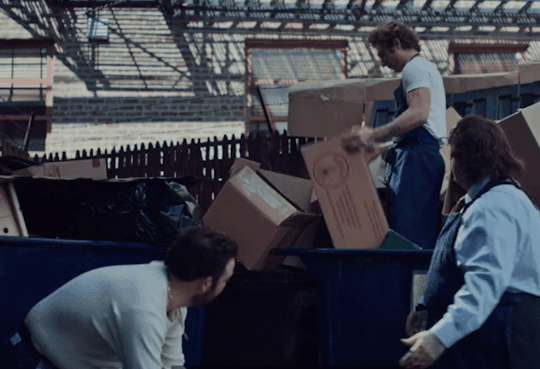
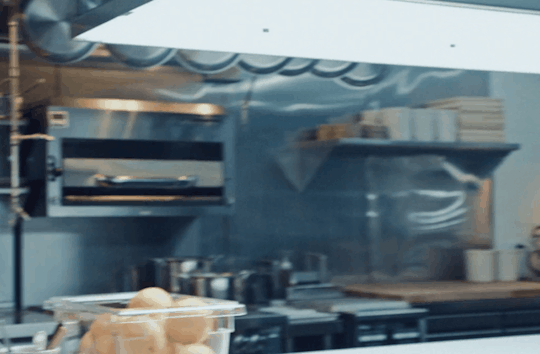
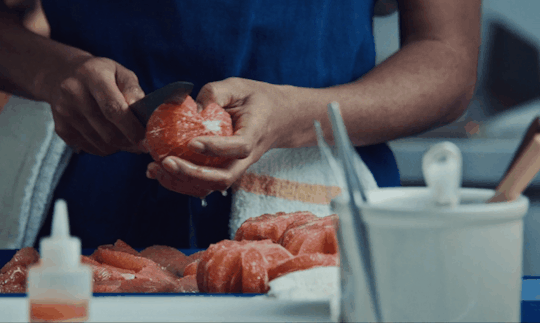
What are the odds of a parallel between knives and boxes, and it's only Carmy and Sydney being frustrated by the tasks of cutting and breaking down boxes?
It's the symbolism of sexual frustration between them.
Textbook Sublimation
Another Freud concept is sublimation - this is defined as redirecting sexual desire into socially acceptable behaviors or new aims that are still related to the sexual impulse. (AKA Carmy wants a star, not just to beat Chef David- but what carmy truly wants sexually is to please Sydney)
Remember what Richie said about Carmy as he shouts at him and then Carmy looks at Sydney?

Let's definite what textbook sublimation is:
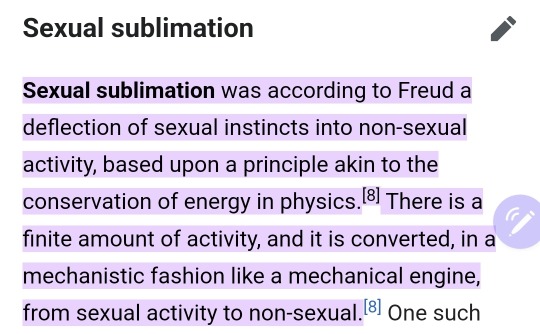
My theory is that Richie told Carmy that he sees him for who he really is. He knows Carmy and knows that he never wanted Claire in the first place. Richie is aware of the tension between Sydney and Carmy, and Carmy's been repressing it all along. Richie is very observant; look at how he observes the tension between Carmy and Sydney.
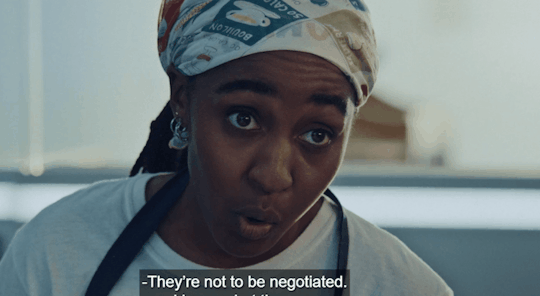
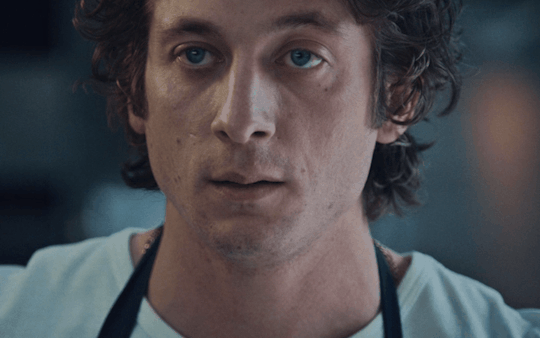
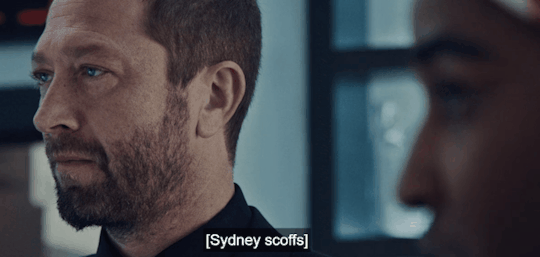
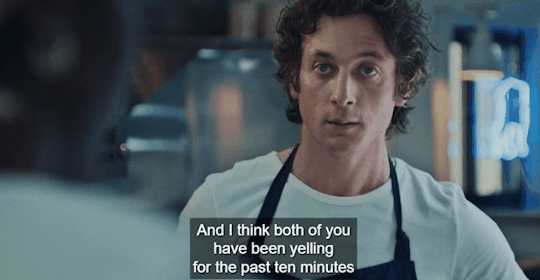
Bonus: Look how Carmy stares at Sydney- he could care less about the Faks in this moment. He's feeling bad for giving her a headache but he wants to fight some more.
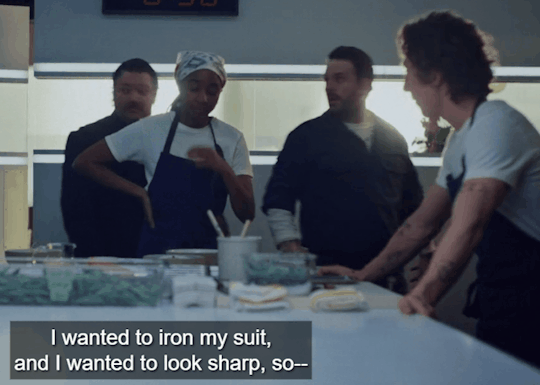
Remember, we theorize here that season 3 breaks into the fourth wall. At that moment, Richie is talking to the audience, giving us a rundown of why Carmy avoids and creates a prison in his mind. We didn't get a clear answer because we were inside Carmy's mind throughout the season. He was experiencing confusion, repression of his urges, and an inability to feel the pain he was going through. Another thing is that he could not accept any joy or love in his life.
I believe the decision to create a surrealist-style season is great because it complements Carmy's avant-garde food style, through which he communicates his artistic thoughts and feelings.

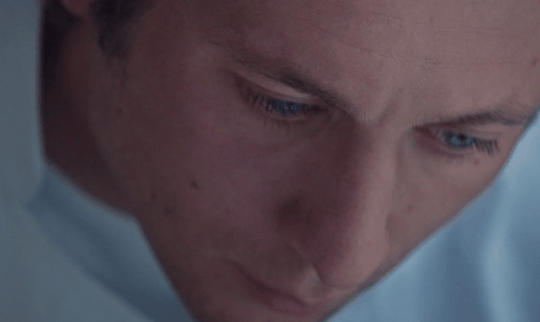
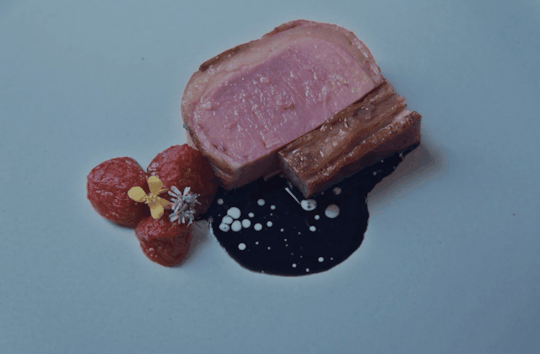
Through the image, we see that Carmy is in a dreamlike state, gazing at the dish he created unconsciously, which matches Sydney's scarf. This hits at the core truth of his desires that he does not want to address. Sydney is the real fun, joy, and amusement that can happen, but he's been sabotaging and repressing since day one, even with the choice of dating Claire. Carmy is more addicted to adrenaline, stress, chaos, and guilt.
I believe the bear in his dream symbolizes the Carmy's unconscious and repressed feelings - desires, guilt, and longing. These emotions overwhelm him as he returns home and processes his grief. The phrase "let it rip" carries multiple meanings, but in this case, I interpret it as a call for him to embrace his emotions and be true to himself.
Thank you for reading.
#sydcarmy#im not a doctor i just love film and psychoanalysis#long post but fun to write hopefully fun to read#i really appreciate sydcarmies! thank you for reading my thoughts#carmy x sydney
166 notes
·
View notes
Text
Nevermore Theory: It’s not about “The Tell-Tale Heart”
Okay, it’s time for another Friday night rant.
Recently, I’ve been coming across some excellent thoughts and predictions about Season 2, so now I’m ready to throw own my hat in the Nevermore Theory ring.
In Nevermore, almost every character is based off of one of Poe’s works. Lenore is from the poem “Lenore”, Morella is from the short story “Morella”, Prospero is from “The Masque of Red Death”, etc. There are also some characters that draw on more than one of Poe’s works, most notably Duke who takes inspiration from “The Cask of Amontillado” (Fortunato) and “The Duc de L’Omellete” (Duke).
Now, Annabel Lee is obviously based on the poem “Annabel Lee”, which the webcomic even opens with, but @moxiepower2 and @takescrackseriously have also made the connection between Annabel Lee and “The Tell-Tale Heart” and theorized that Annabel might also be a dual-themed character like Duke. I personally find that reading very convincing too!
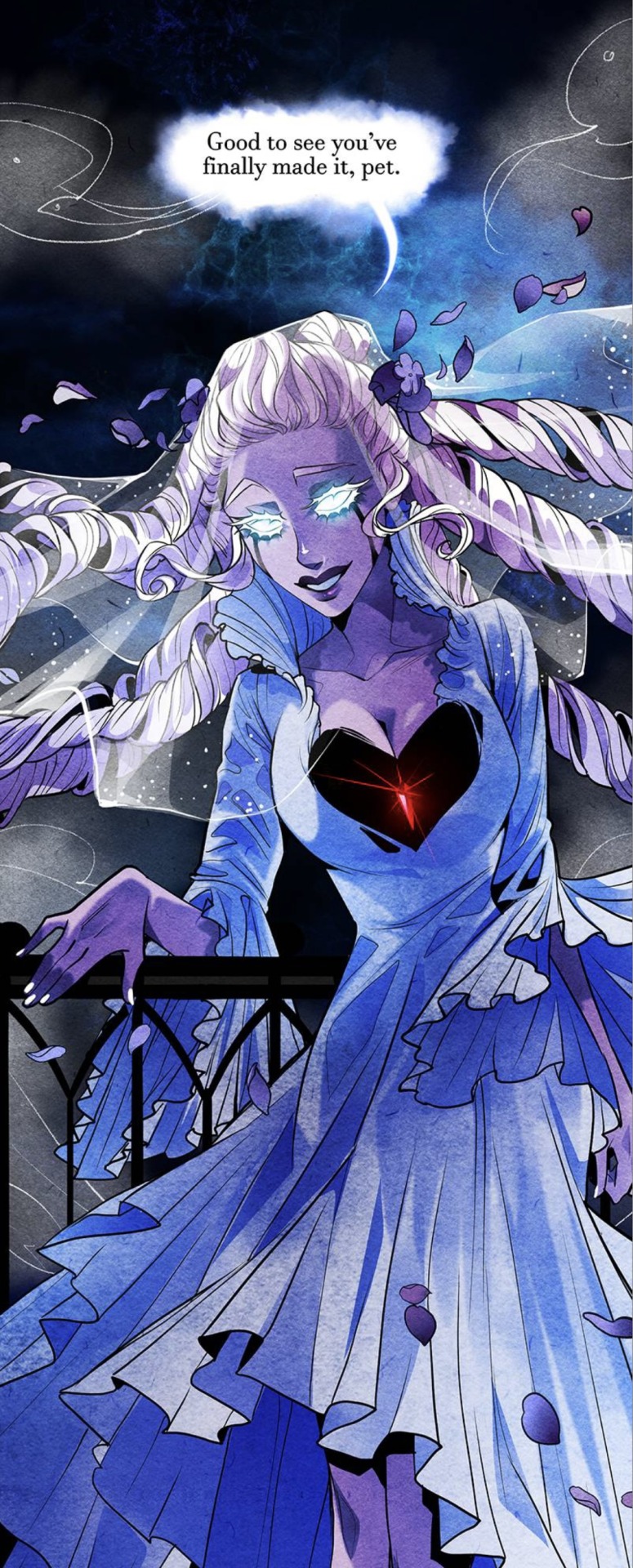
(I mean c’mon, her spectre has a giant heart-shaped hole in it, the logo for the WEBTOON is beating heart with wings, it’s one of Poe’s most famous works, so on and so forth.)
But today, I’m going to stick my neck out and say, it’s NOT about “The Tell-Tale Heart” (at least not entirely. Annabel Lee could be based on even more than two works!).
I think Annabel Lee’s character points to another of Poe’s stories that lines up really well with the direction of Nevermore as a whole:
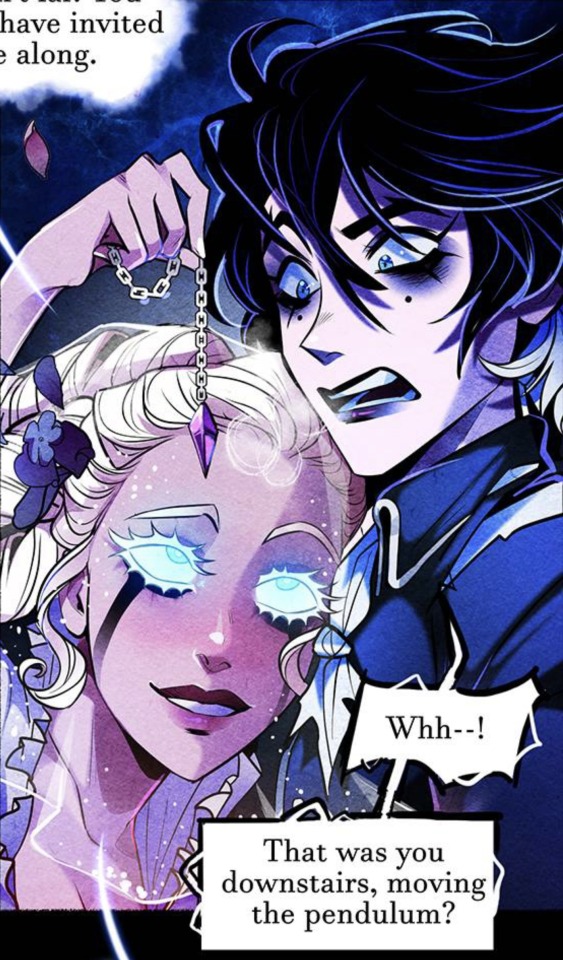
That’s right, it’s time to talk about “The Pit and the Pendulum”.
First, I’m going to need to explain this leap in logic, because it’s definitely not as clear as Annabel’s heart motif. Let’s start with the visuals.
Yes, Annabel Lee and Nevermore in general have a strong heart motif, but isn’t it a little odd that Annabel’s heart isn’t totally empty?
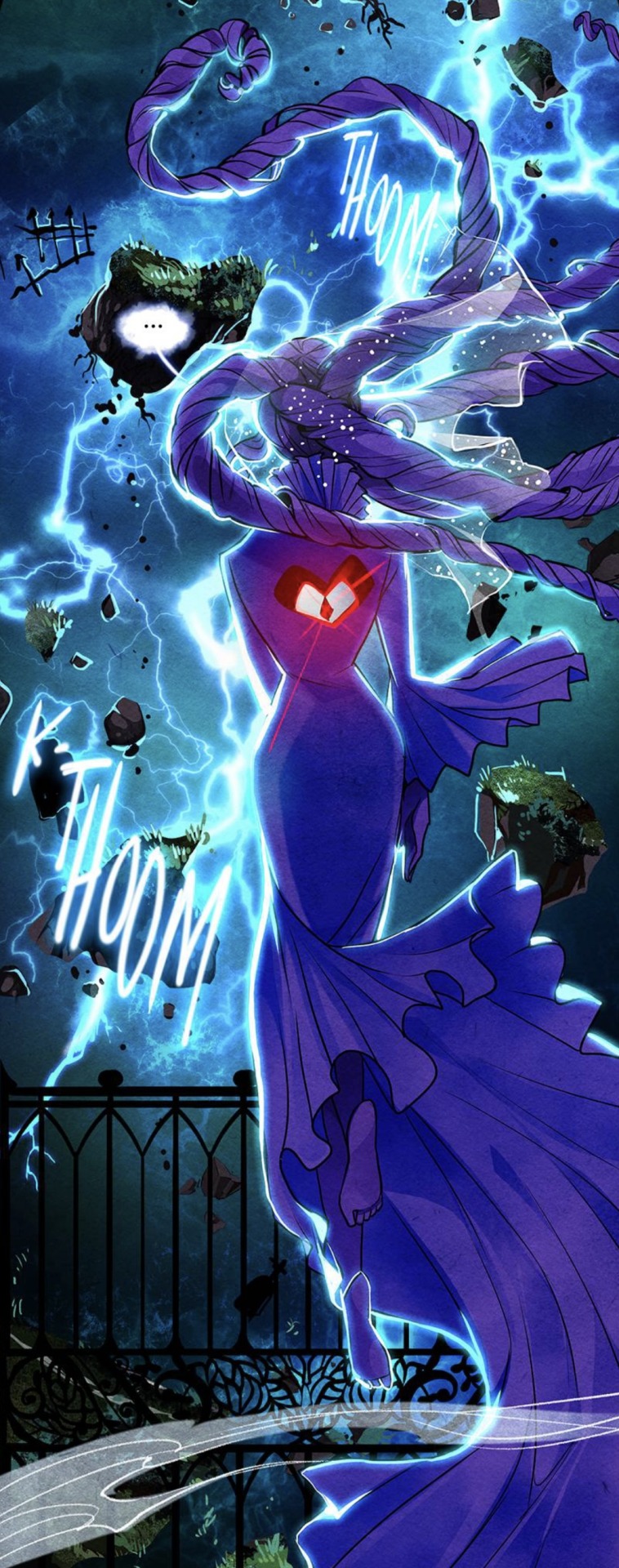
It’s a great visual focus for her character design, but that shape is awfully familiar, and it swings around an awful lot like a pendulum, doesn’t it?


And we know that Annabel (as an actual ghost-type spectre) can control the pendulum.
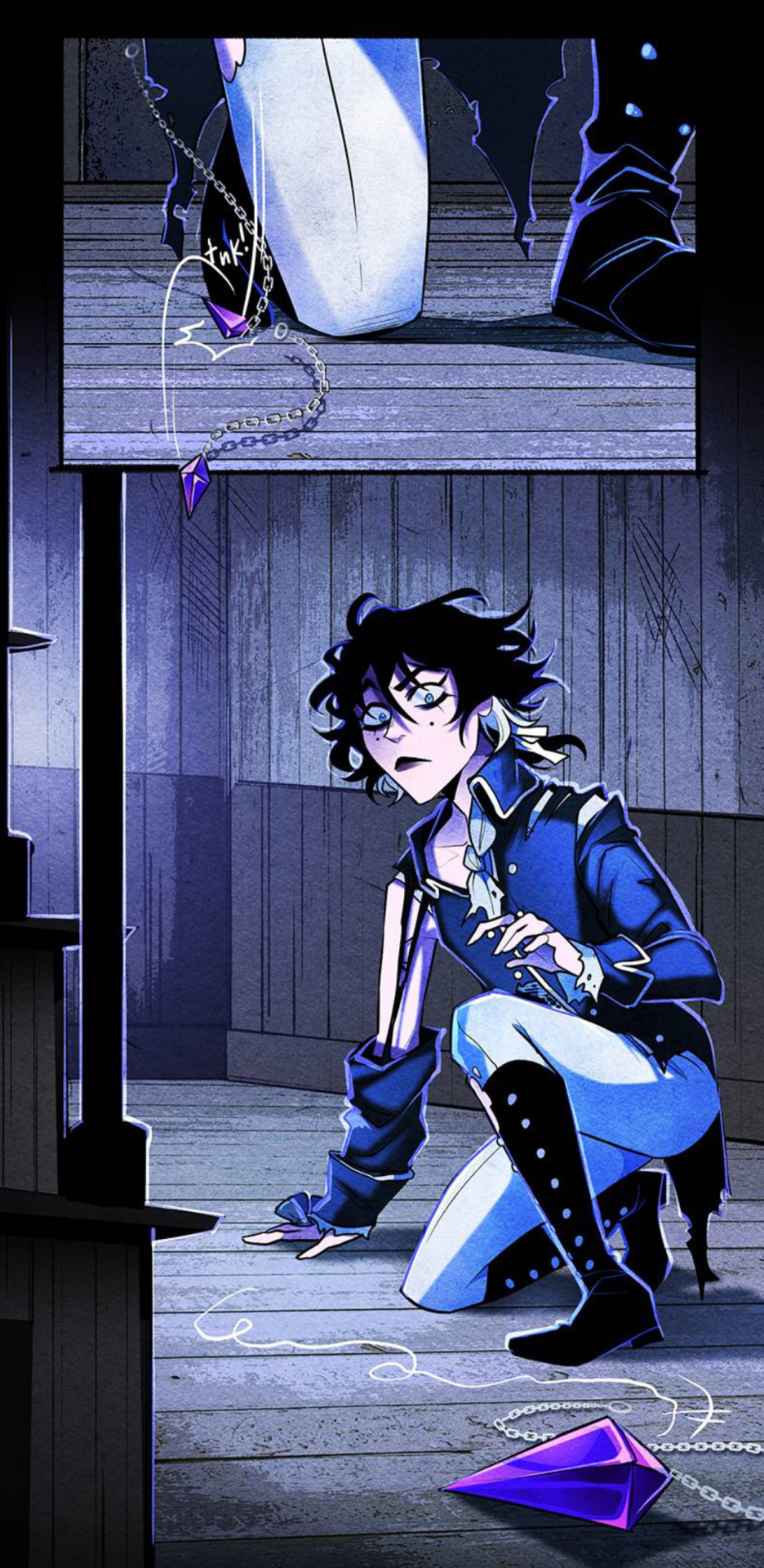
AND Annabel Lee gives the pendulum back to Lenore, with a lock of her hair tied around it, literally binding herself to the tool.
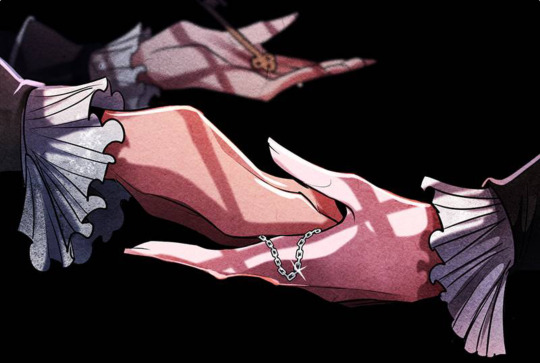

That’s… an awful lot of interaction with an item that is unrelated to her inspiration poem AND has served exactly zero purpose in the story so far. There HAS to be a reason Red and Flynn keep bringing this damn thing up because they play the long con with their foreshadowing (Dirt on Ada’s hands, Annabel Lee’s panic attack, Lenore taking Annabel’s blot, the gun having no bullets at the very beginning of the webcomic).
So now, I want to delve further into the actual text of “The Pit and the Pendulum” because it mirrors a lot what we’ve seen so far in season 1 and could be a good start for predicting what comes next in season 2!
For those who haven’t read “The Pit and the Pendulum” it follows an unnamed narrator who has been arrested by the Spanish Inquisition, pronounced guilty to some crime (it could have been anything, that’s just how the Inquisition rolls), and is subjected to all kinds of unusual torture methods before being rescued by the French army.
What I find so interesting about this story though is that its structure loosely matches the trials that the Deans have set up at Nevermore Academy.
For instance after swooning at his sentencing, the narrator wakes up in a pitch-black room and tries to figure out the shape of his prison by making a circuit. He finds that it’s around a hundred paces, but because of the “many angles in the wall” he can “form no guess at the shape of the vault”. In reality however, the room is perfectly square and only half the number of steps in circuit.
How did the narrator make such a big error in estimating the size of the room? Because he passed out right after missing the marker he had been using to keep track of his location, thus making two laps instead of one.
Now let’s compare it with the first obstacle for Nevermore students, the Labyrinth. Students are thrust into the maze without any knowledge of how to manifest (Annabel only knowing how to because of the Deans making a surprise appearance in class). So metaphorically, they’re also in the dark, and as Lenore and Duke find out as soon as they enter the maze, the labyrinth’s geometry also seems to shift.
Most convincingly (in my opinion), Lenore also looses track of herself during the Dementophobia trial, just like how the Pendulum narrator faints, which is one of the main reasons the misfit trio almost fail.
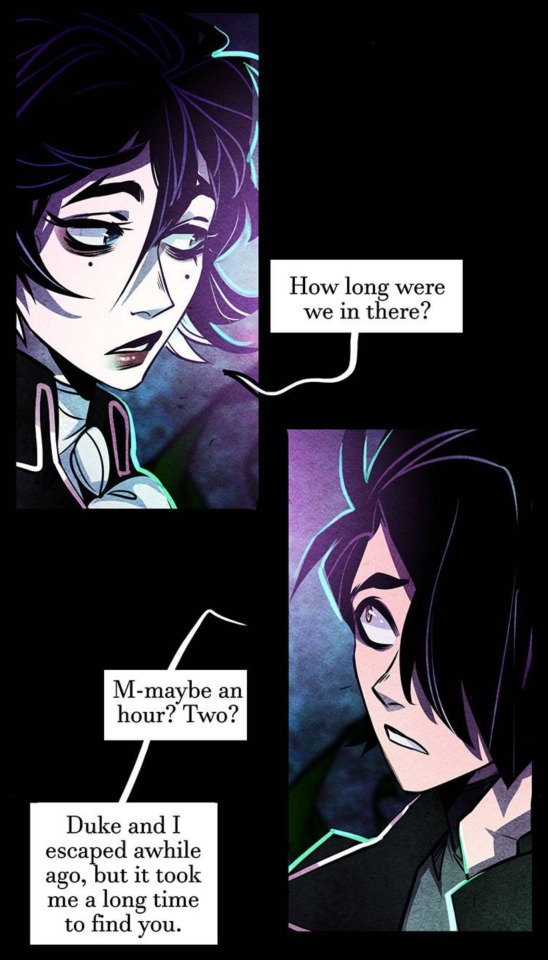
That near failure also mimics what happens next in the short story, the narrator trips and narrowly avoids falling into a giant pit (hence the title).
That really ticks off the Spanish Inquisition, just like how Lenore pisses off the Deans by surviving, and so the Inquisition does what it does best, and devises a new torture method. This time, the narrator awakens to find himself strapped down to a plank and gazing up at a figure of Kronos, only instead of Father Time wielding a scythe, he’s wielding a massive bladed pendulum (there’s the second half of the title, you’re welcome).
I find this image very telling because it’s supposed to relay the message that the narrator’s death is inevitable. You can’t fight the passage of time, and it doesn’t get less subtle than the god of time killing you with a clock part.
Similarly, ringing the bell in the widow’s watch is supposed to be an impossible task, meant mainly to give the students who have manifested a chance to flex their powers. The Deans admit as much:
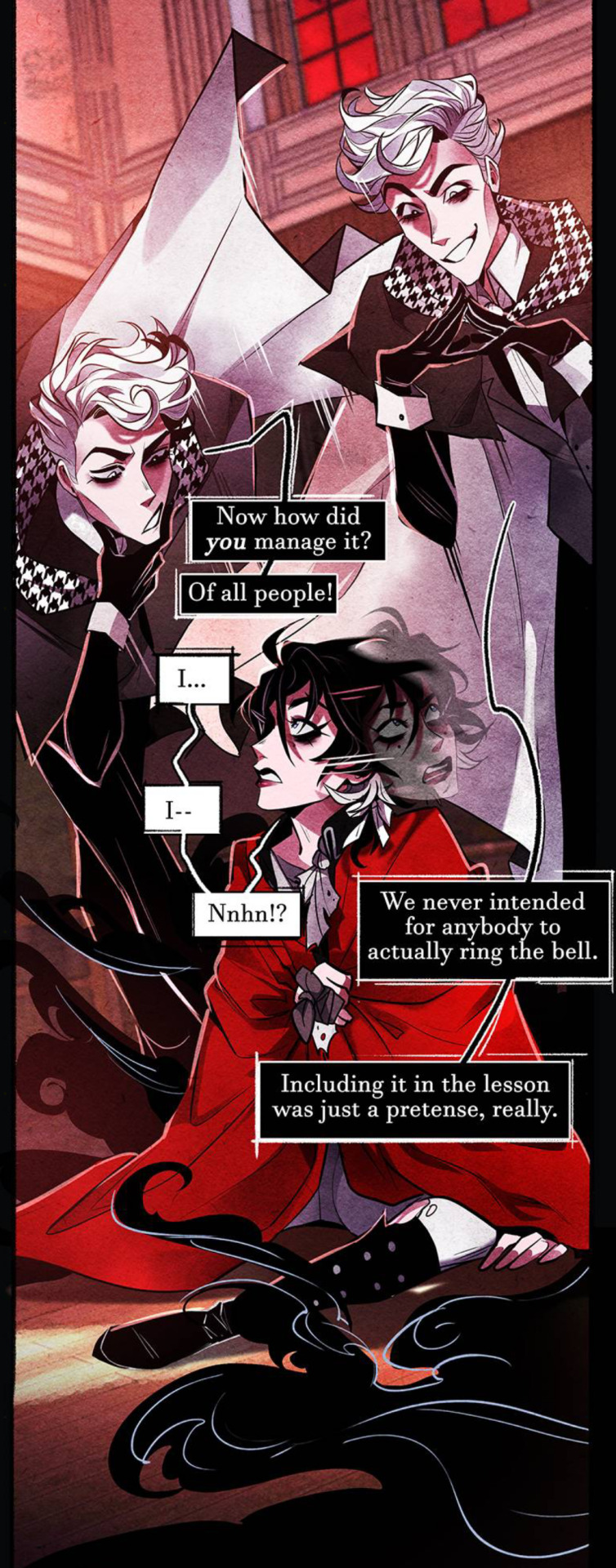
But back to the short story, the narrator doesn’t exactly realize his predicament at first. He just thinks it’s kind of an interesting change of scenery and he’s more worried about the fact that his captors have provided him with “meat pungently seasoned” and no water to quench his thirst, which he figures is the real torture method. Oh and the rats. They’re pretty scary too, especially when it occurs to him that he’s definitely not the first person to be shoved in this room, and those rats have to have been eating something.
Eventually, he does notice the pendulum slowly lowering and spends the next *checks notes* 9 paragraphs alternating between despair, apathy, and frenzy. (There’s actually quite a lot to dissect here with regards to Nevermore’s treatment of madness, but let’s save that for later.)
Then he gets a bright idea and rubs spicy meat all over his bonds with the one free arm the Inquisition left him to presumably eat said meat.
Why does he do this?
To entice the rats into eating his bonds, of course! He has to play dead for a bit, and also let rats crawl all over him, but it works and our narrator escapes after a few cuts.
Okay, now let’s take a look at the parallels to that trial in Nevermore. I’ve already gone over the comparison to the bell ringing class as a kind of Sisyphean task, but Lenore also almost gets eaten by Prospero’s rats:
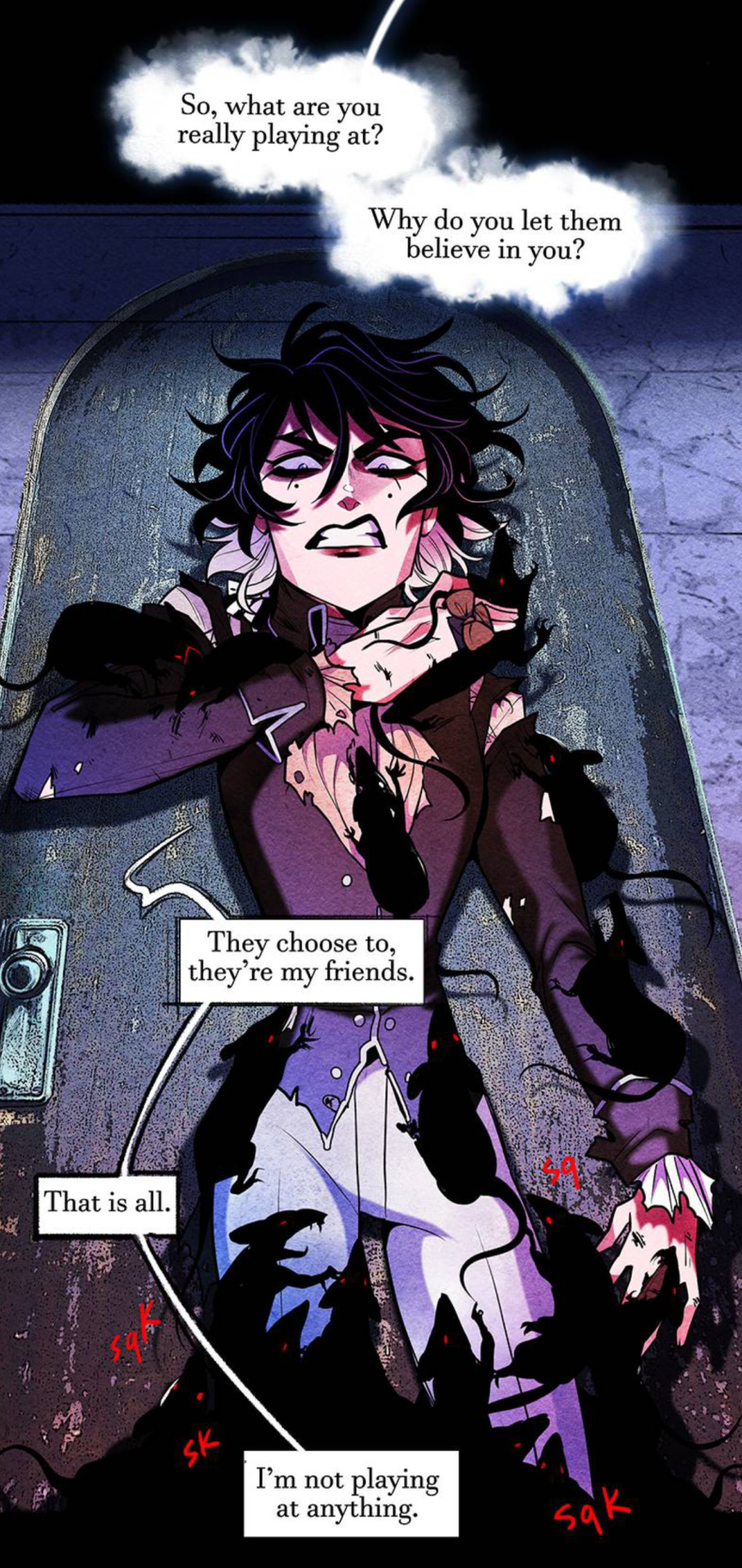
She also succeeds because the people, who are supposed to be her enemies, help her, just like how the rats aid the narrator in escaping. Did I just compare Ada, Pluto, Morella, and Annabel Lee to rats? Yes. Yes, I did.
But I’m going to specifically single out Annabel Lee in this case because Lenore also has to play dead in order to ring the bell. Specifically she pretends to give in to Annabel’s “Kiss of Death”.


So both Lenore and the narrator are momentarily successful after reports of their death are greatly exaggerated.
Then they have the crushing realization that they’re still trapped. Then narrator in the dungeons of Toledo, and Lenore with…
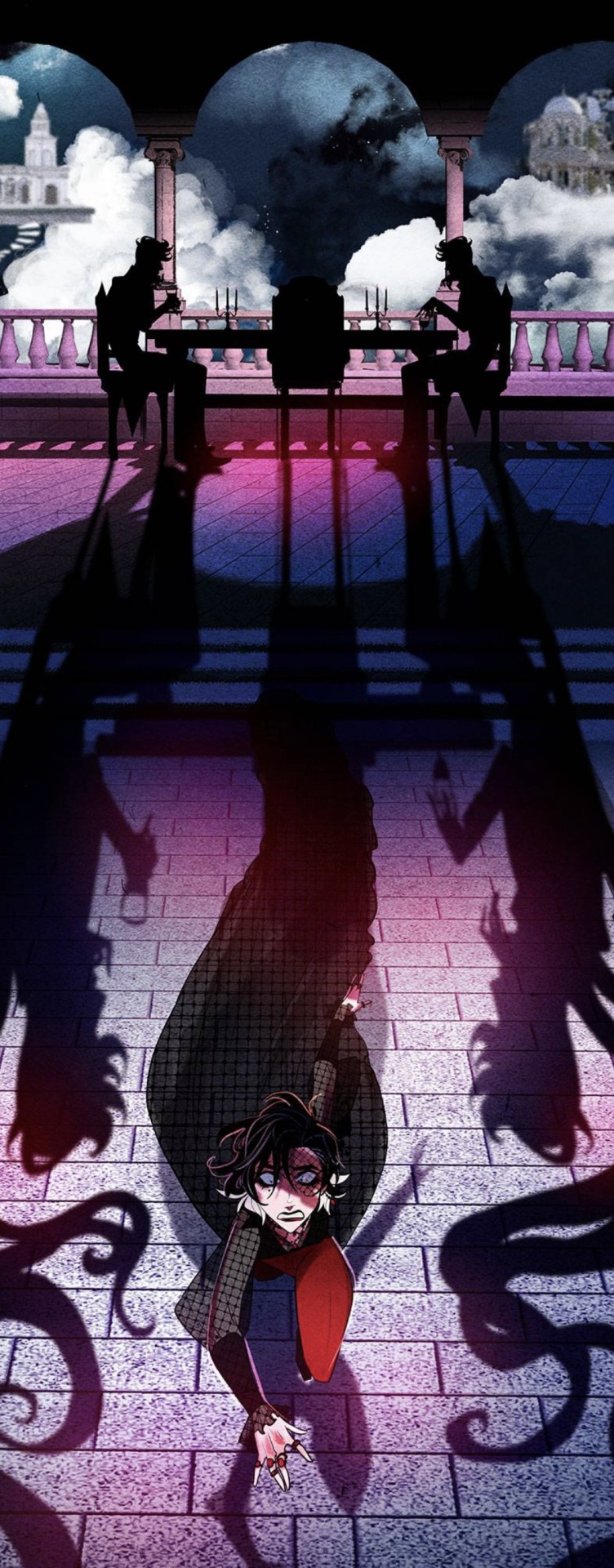
(Minor aside, this is some phenomenal scene work.)
And now the final trial (for our hapless narrator at least). The Inquisition, having been denied their sliced prisoner sandwich, decide to roast him alive instead. You see, the metal walls of the cell can actually be heated up, oh and also they can flatten themselves by pulling the corners apart like a collapsing square.
So the narrator has two choices. Death by being burned alive, or death by falling into the pit at the center of room (remember that detail? It’s still the same room).
To put it in Nevermore terms, Lenore can either test her luck with the Deans OR:
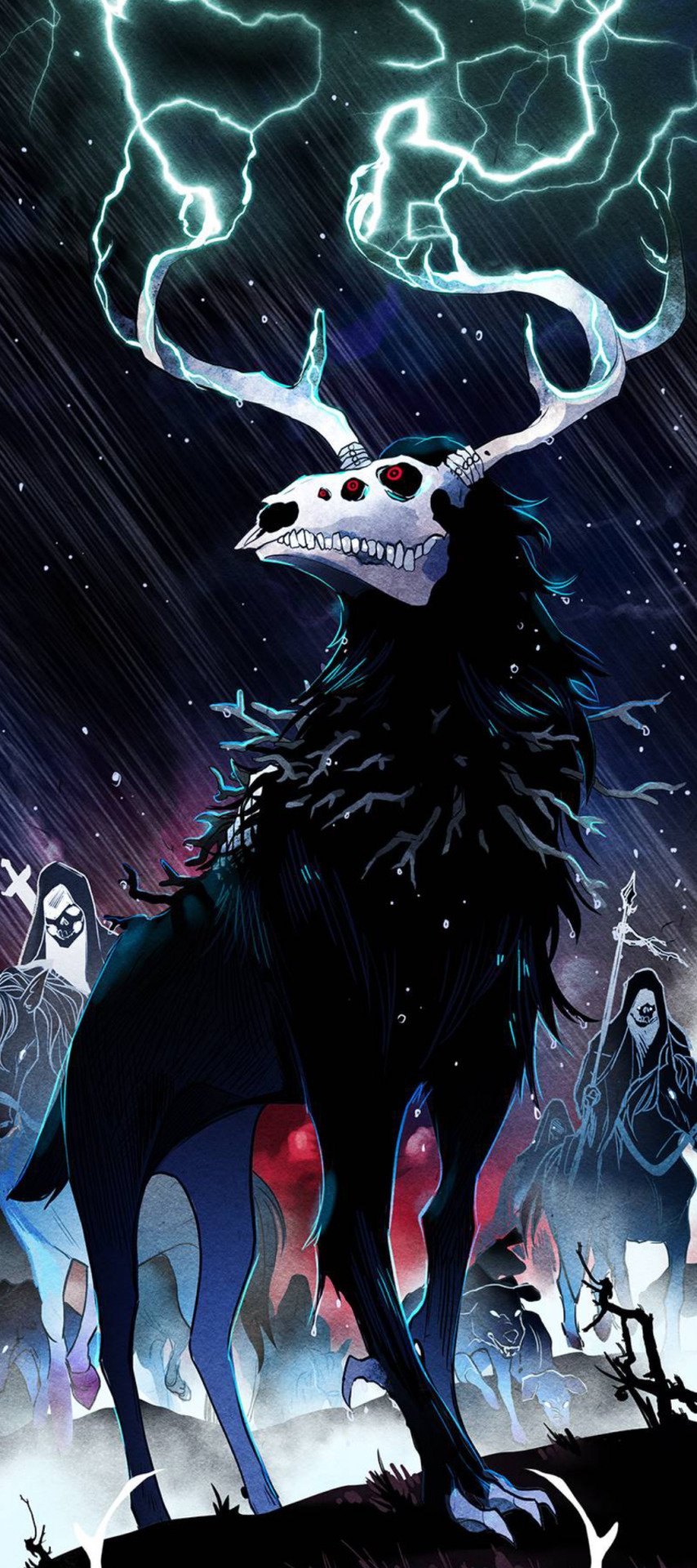
This guy :)
Now, do I think the Deans created The Wild Hunt? No, and I would be very interested in if the Stag turns out to be related to Theo in some way, but I bet the Deans purposefully invited The Wild Hunt into the Academy in order to corral them back into obedience/kill off the troublemakers. (Or maybe they were just bored, who knows?)
NOW FOR THE ACTUAL THEORY PART (How in the world did it take so long to get here? I only have a paragraph left in the short story to use for theory crafting!)
”The Pit and the Pendulum” ends with the narrator being saved literally as he is falling into the eponymous pit by General Lasalle of the French army. That doesn’t make sense because Lasalle wasn’t in the Battle of Toledo where the story takes place, but anachronisms are incredibly prevalent in Nevermore. Pretty much every character comes from a different time and place than the others, most prominently Eulalie, who is probably Japanese and probably died in WWII (though who knows, maybe she was a proto-weeb and died in the firebombings of Dresden).
My theory is that similarly, the main cast is going to be saved by a third party who intervenes during the Hunt. Then, the narrative is going to shift away from Nevermore Academy and towards the afterlife at large. We’ve gotten plenty of hints about the outside, particularly towards the end of Season 1, so I don’t think it’s that unlikely, and if I may make a second literary connection, Nevermore is kind of like the Hunger Games.
Wait! Let me explain.
You have a group of kids/young adults fighting in a premade arena designed by antagonistic game makers where only one of them can come out alive. Generic? Yes? But looking at the Hunger Games Trilogy’s structure, we start with the Hunger Games, get a variation in the Quarter Quell, and then abandon the games to explore a broader scope of the world.
Now, I have the utmost faith in Red and Flynn’s ability to keep the dark academia setting fresh, but the path of least resistance might be getting out of the classroom.
It’s a weak and vague theory, that I don’t even really subscribe to myself, but I thought I should follow the short story to its end at least.
But if I don’t believe in my theory, why did I bother spending the last two hours writing this post?
Well, one, I really like pointing out the parallels between Poe’s work and Nevermore. It’s clear that Red and Flynn put so SO much effort into Nevermore and I genuinely think getting to be in on all those details enhances the reading experience.
But two, do you remember how I started this post?
That’s right, talking about Annabel Lee.
I’ve been doing a lot of comparison between Lenore and the actual text of “The Pit and Pendulum” but I want to show you this illustration of the short story by Harry Clarke:

Does that outfit remind you of anything? Maybe…
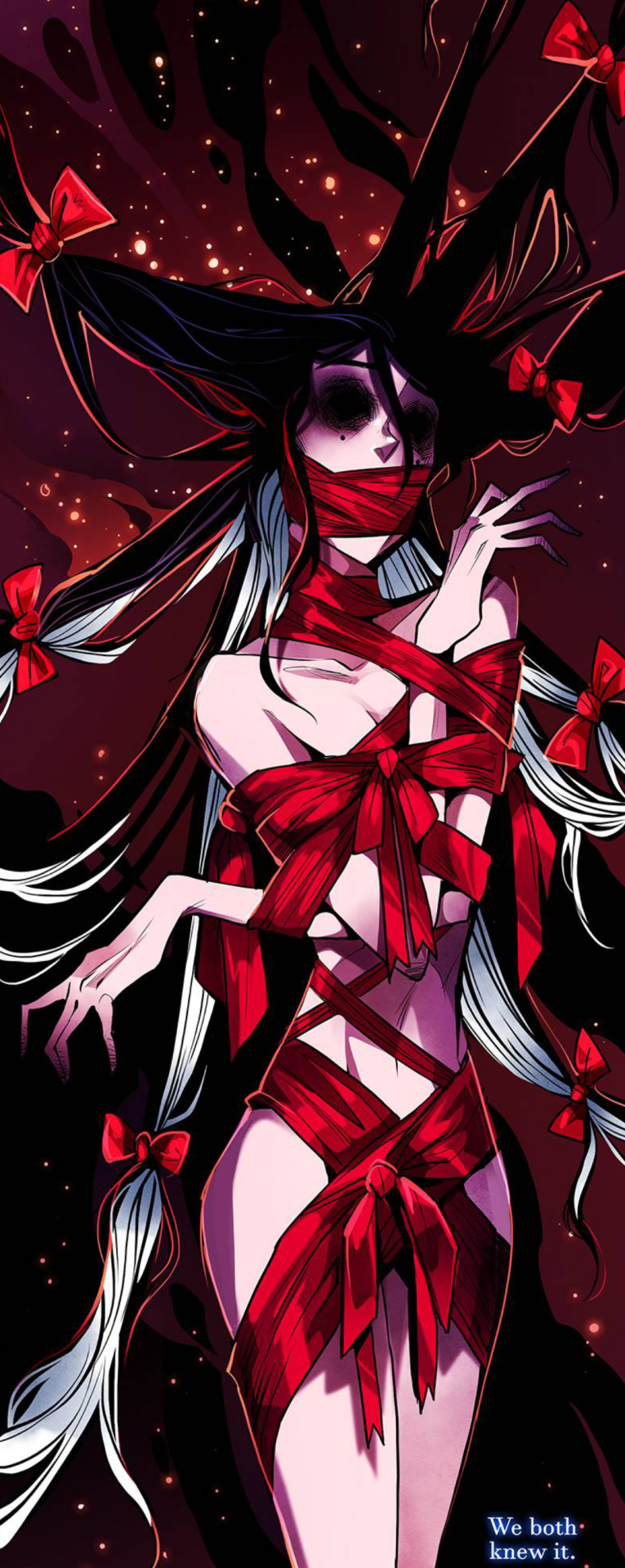

Now, Clarke drew the above piece nearly 80 years after “The Pit and the Pendulum” was first published, but considering how prominent this illustration is for the short story, I bet Red and Flynn studied it when writing Nevermore, and I find that really intriguing considering where they chose to reuse the outfit.
There are ribbons all over Nevermore (everyone with a ponytail has one to tie up their hair, Ada uses hers to set Lenore’s broken fingers), but the motif of being bound by ribbons occurs when the narrative is invoking ideas of madness and memory, specifically for Annabel.
And would you look at that. “The Pit and the Pendulum” brings up both of those ideas together: “the madness of a memory which busies itself among forbidden things.”
That’s the last line of the third paragraph, and it’s exactly what Annabel is doing in the bathtub, recalling taboo memories of Lenore.
Plus, this passage happens as the narrator is trying to recover from a swoon, and what do you know? There’s only one character in Nevermore who swooned in season one: Annabel Lee.
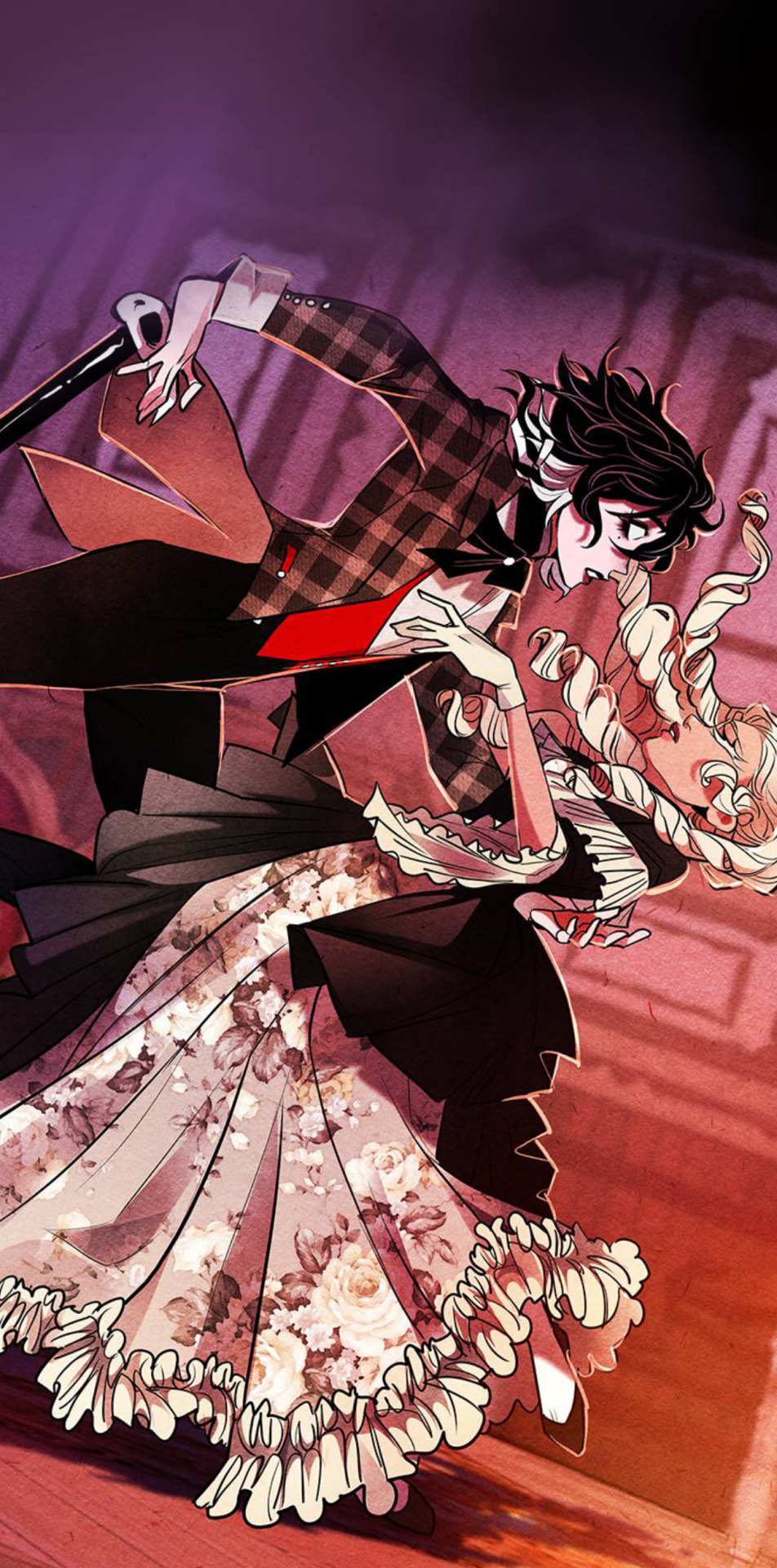
Okay? So? Nevermore already has a lot of parallels to this damn story, and I’ve spent the entire post point them out for crying out loud.
But! Poe is very specific about how we recover from a swoon:
“In the return to life from the swoon there are two stages; first, that of the sense of mental or spiritual; secondly, that of the sense of physical, existence. It seems probable that if, upon reaching the second stage, we could recall the impressions of the first, we should find these impressions eloquent in memories of the gulf beyond.” (Emphasis added)
Again, doesn’t that sound familiar? Throughout season 1, the main cast have all been slowly recovering their memories and thus unlocking their spectres which represent fragments of their true selves and desires.
So here’s my actual theory: in the past, Nevermore Academy was used by lost souls to recover their “mental and spiritual” identities, before they reclaimed their “physical existence” at the light beyond the grounds in order to “return to life”.
More importantly, I think the final arc of Nevermore (or epilogue I guess is more likely?) will take place in the mortal world and be about the cast “[recalling] the impressions of [their mental or spiritual senses” (ie. their time at Nevermore Academy) post-second stage, thus completing Poe’s perfect recovery.
Reincarnation isn’t Nevermore’s endgame.
Maybe they have to leave their spectres behind at Nevermore Academy like in the “Theo is the Stag” theory and the final act is about them reclaiming their personas stands spectres to fight against the Deans, or maybe we’re going to go Kimi no Na wa and just get them running into each other and remembering (which would be lame) or Annabel being the only one who remembers and gradually hiking across the globe to find the others (which would be a very cool reversal given how Lenore is usually the one trying to form genuine connections [we’re starting to see some promising Prospero-Annabel friendship development though!] but now we’re also getting into fanfic territory).
Personally, my happy ending at the moment would be Annabel and Lenore teaming up, kicking the Deans out, and reestablishing Nevermore Academy as a sojourn for reincarnating spirits. That way we don’t have to go through reincarnation drama (again) and everyone who sticks around can just chill out and lead peaceful (after)lives or be teachers and show newcomers how to awaken their spectres. But again, fanfic territory.
Wow, that was a whole lot of text that didn’t really amount to an actual theory, but I hope you guys enjoyed reading it?
TLDR if you didn’t: Nevermore season 1 is actually a sapphic rewrite of “The Pit and the Pendulum”, the Deans are the Spanish Inquisition, and the Nevermore’s endgame is going to take place in the mortal world after reincarnation.
Also, I have no spine like Ada and don’t have any conviction in my theories lmao
#nevermore webtoon#nevermore webcomic#annabel lee nevermore#lenore nevermore#duke nevermore#morella nevermore#ada nevermore#nevermore theory#fan theory#theory time#edgar allan poe#the pit and the pendulum#rednflynn#parallels#too much writing#Fanfic#territory#season 2 hype!#ribbons#the hunger games#nobody expects the spanish inquisition#Yes I read and fully annotated “The Pit and the Pendulum” for this post#What Poe work should I do a deep dive on next?#Friday Night Rant#Oh god no#They’re actually becoming a thing for me
99 notes
·
View notes
Text
Why I believe Audrey two is Seymour's subconscious and not a man eating plant.
I need everyone to hold my hands, look me in the eyes and listen carefully when I say this is my own interpretation based on the musical 2022 production with jeremy jordan and christian borle.
Trigger warnings for: themes of mental illness especially psychosis, mentions of suicide, murder, dismemberment, paranoid delusions, reality not being what it seems, blood and gore and anything else in relation to little shop of horrors.
OK ANYWAYS ON WITH IT !
point number one: Seymour is not mentally well.
He is so open to persuasion and peer pressure as shown not only by how quickly he folds when audrey II asks him to feed him BLOOD but also with how easily mushnik is able to make him his son (my baby seymour is so lonely and desperate for any positive attention). He definitely has depression and in this theory i believe he also suffers from psychosis. The initial feedings to audrey II are acts of self harm as a result of his mental illness.
point number two: audrey II as an extension of seymour.
Audrey II becomes a confidant to seymour, especially when facing ethical dilemmas and his own moral ideals - see feed me (get it) where he becomes convinced orin deserves to die - however i don't think that it is as literal as it is shown on stage. audrey II is an extension of seymour's conscious and subconscious that seymour's psychosis creates as a visual outlet for his own feelings. In reality i theorised that audrey II is a simple plant. although it IS a new discovery it does not become sentient but still brings fame and fortune to mushnik's florist. You may be wondering, well why does he feed it blood then? MENTAL ILLNESS BABEY!!! bringing us back to point one that seymour's subconscious needs to rationalise everything, including that he needs to "feed" this plant to keep revenue coming and reward it for bringing him fame.
point number three: seymour's hands.
Let's skip forward a little bit to when seymour tells mushnik that he needs to go into the plant to retrieve their money. Specifically during this production (as far as i know) seymour gestures to audrey II whilst its mouth opens and then when it begins to close onto mushnik, he stares at his hands and turns them over - reminiscent of characters who have killed and stare at their hands in shock/ in awe of blood that coats them. I believe that seymour does this to show that mushnik does not actually get eaten by audrey II in reality, but is instead murdered by seymour using his hands and then dismembered - similar to orin - and hidden in soil around the florist, but mainly in audrey II.
point number four: audrey II relaying seymour's inner thoughts.
When mushnik confronts seymour initially about his murder of orin and asks him to go to the police, audrey II comes alive with another presence on the stage for the first time in the show (i do not count when someone is being fed to audrey II e.g orin's corpse/mushnik getting into audrey II or audience interaction). Audrey II drives paranoia into seymour's forefront of his mind with his words, getting more and more intense as mushnik tells him to go to the police and prove his innocence. Seymour's irrational and paranoid mind creates this driving force via audrey II, giving him the ability to rationalise the killing of his father figure lest he go to prison.
point number five: orin scrivello DDS.
Orin's death could be labelled a convenient accident - but thats what seymour wants to think - his inaction in helping orin out of the mask is the direct cause of his death and although it is not the same as shooting him point blank, i still consider this an act of murder, the first of many. As mentioned previously seymour is very easily convinced that orin deserves to die for his abusive acts to audrey I, and rationalises that he MUST kill him to feed audrey II who has rewarded him with fame, fortune, and eventually audrey I. He rationalises orin's murder which is the start of his aggressive downward spiral into deeper psychosis and murder and then buries him in audrey II's soil.
point number six: audrey I.
Audrey I is seymour's core desire and main motive for most of his actions - he takes various contracts for money to provide for audrey, he kills orin for audrey's safety, he kills mushnik so he doesn't get turned in for orin's murder and so he can stay with audrey. Everything is centred around audrey because she is a large driving force for seymour. Her influence on him is shown during feed me (get it) in the instrumental section when orin slaps audrey for forgetting her sweater in front of seymour, this is the turning point for seymour's morality and he becomes of the belief some people deserve to die - especially orin.
point six and a half: audrey I going somewhere that's green.
Now let's get to the more complicated part of audrey I's death. NO ONE PANIC I AM NOT THROWING AWAY THE THEORY BECAUSE SEYMOUR ISN'T IN THE SCENE INITIALLY THAT'S ACTUALLY AN IMPORTANT PART OF IT. Seymour experiences a pure psychotic break, hence audrey II being the only one present for the scene initially and conversing with audrey I for the first time. Audrey II IS seymour, just the part of him he harshly represses and barely acknowledges, hence the manifestation of audrey II as a man eating plant. He accidentally fatally injures audrey I and as she dies in his arms, he needs to rationalise it all as a lone act committed by audrey II and not himself. Seymour buries her in the soil along with orin and mushnik.
point seven: audrey II and detaching seymour from reality.
Audrey II serves as a way for seymour to disconnect himself from the reality of his crimes, creating a completely separate entity deemed to feed on blood (fresh and human - why was that specified? to rationalise the murders) and has evil motives (world conquest). What we see is not reality, but what seymour sees.
point eight: seymour's death/suicide.
We see seymour dive into audrey II in an attempt to kill it from the inside, in line with this theory i see this as seymour committing suicide in horror at his own acts and the part of him which manifested as audrey II in his mind. He willingly enters the 'man eating plant' which he has seen eat three separate people with only a small machete, implying he wouldn't know the outcome is death implies he is an idiot. i have theorised that he comes to after audrey I's death and burial and in horror and shame of his murderous acts and the way he justified them he chooses to kill himself - mostly due to the death of audrey I - in order to kill the part of him that allowed those things to happen. Kind of a Jekyll and Hyde situation, killing yourself to kill the second person inhabiting your body and brain.
point nine: the finale.
The finale we see is seymour's final brain functions, bringing all his rationalisations and delusions to a head, where audrey II lives on and goes on to conquer the world with millions of other man eating plants. He gets to see all his victims one final time, and shares a warning to not feed the plants, no matter what they offer you - do not feed delusions or rationalise evil deeds no matter the positive outcomes. Speaking of positive outcomes !
point ten: the rewards system tied to audrey II.
What emphasises and solidifies the rationalisations and delusions are the positive things that happen around seymour as he kills, such as getting into a relationship with audrey I, money, popularity, getting adopted, multiple contracts etc. Reminder that what we see in the show is seymour's perceptions, and that i theorise in reality they are much less positive and are blown out of proportion by seymour so that they are a significant positive outcome of his negative acts. He does not get together with audrey I, they simply interact more than before, the contracts are bad deals, the money isn't as great as it seems, he gets adopted but as we see in the show it is for ulterior motives (seymour sees it as an act of pure love).
conclusion:
I have little shop of horrors brain rot and i love this theory so much it adds a whole new layer to the show, especially the ending ! love the character of audrey II but i also love the idea that he is a manifestation of seymour's subconscious and not actually a man eating plant.
i did not proofread this. hope you enjoyed :)
#little shop of horrors#audrey 2#seymour krelborn#mr mushnik#audrey ii#orin scrivello#seymour lsoh#audrey lsoh#orin lsoh#little shop theory#lsoh#lsoh twoey#jeremy jordan#christian borle#little shop of horrors musical
192 notes
·
View notes
Text
Here's what I wanna know
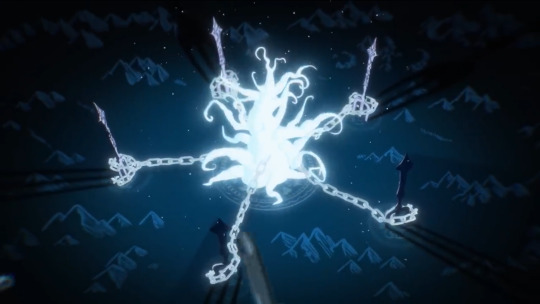
Obviously the Silver Tree is what's in the middle
But what about the FORKS???
They're connected to the tree in this visual representation but idk if they're supposed to be symbolic or literal. Are they a part of the seal? Another aspect of the prison??? We know what the tree does but how do the forks work in this equation?????
WHATEVER they actually are, it's possible those are going to start coming into play with this upcoming Mystic Flour Update. They're probably going to be the main driving force in exploring the rest of Beast-Yeast for the characters. Why?
Well if the Tree was the only part to it, then all they would have to do is camp out in the Faerie Kingdom and defend it. From a storytelling AND gamer standpoint, spawn camping ain't fun. So they need another thing for the characters to aim for: the forks.
They're either the Beast's individual prisons, conduits that are keeping the tree alive (like roots feeding nutrients to it), or some other third thing I can't think of rn.
My quirky little game theory is: Dark Enchantress is going to start going for the Forks because the initial plan with the Faerie Kingdom's Seal went nowhere. Spread the enemy forces thin across the entire continent, lead them on a wild goose chase, and then attack the Tree head-on once everyone is occupied with defending the Forks.
Badda-bing badda-boom ya got the Beasts freed and narrative chaos ensues.
#cookie run#cookie run kingdom#beast cookies#shadow milk cookie#mystic flour cookie#eternal sugar cookie#burning spice cookie#silent salt cookie#theory#theory crafting#mini rant
200 notes
·
View notes
Text
Blue Lock volume cover analysis
An examination of unusual features and chains among the 31 volumes released to date. Subject to revision.
Like this? Want to reference these points in your own analysis on Reddit, YouTube, wherever? Go ahead! A shout out to this post is appreciated. Straight up plagiarism isn’t.

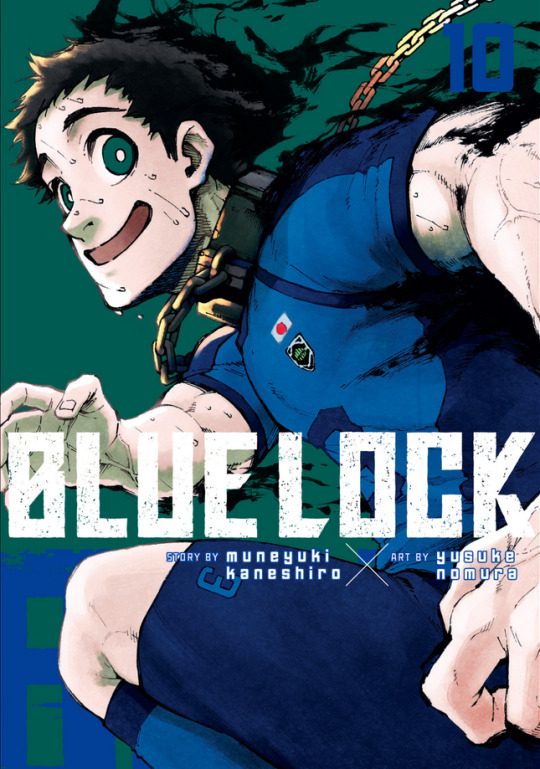
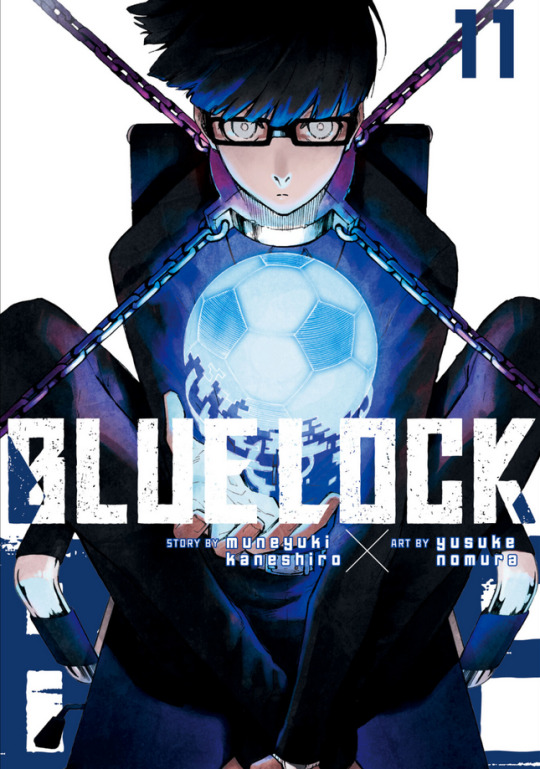
Volume 8: Mikage Reo
Reo's chains are noticeably shaded green. Guess whose eyes glow green when they're fired up...
In addition, @thyandrawrites has a theory that Reo ties/reties his hair up as a way to maintain emotional composure. The volume covers tend to represent the character's personality or struggles in some sense. If so, this is an early nod to the emotional trials Reo endures during the series.
Volume 10: Tokmitsu Aoshi
No chain weirdness here, but Tokimitsu is surrounded by black gunk in his cover. This may be a visualisation of his anxiety and the way he copes with it: running at speed and bulldozing through his opponents.
Volume 11: Ego Jinpachi
Ego's cover depicts him totally immobilised by the four chains bound to his neck. To date, no other character has been more restrained by the chains. This likely represents that Ego's fate is utterly dependent on the outcome of Blue Lock. His cover also suggests that Blue Lock (and football) consume Ego's life.



Volume 12: Shidou Ryuusei
Shidou's chains have a blue glow, much like Sendou's in volume 27. This glow is far closer to Shidou's collar however. It could imply that Blue Lock is the beginning of Shidou's pursuit of football.
He's also depicted with demon wings. The collar or chains don't impede his movement significantly, unlike other characters. In addition to portraying his incredible physicality, this could also visually represent how Blue Lock has failed to subdue Shidou.
Volume 16: Oliver Aiku
Aiku's chains are wrapped tightly around his arm and he's pulling them taut. The chains themselves appear rusted and cracked, most notably on his collar. This could represent Aiku's relationship with football. He grew jaded with being a striker in high school. Becoming a defender, then the match against Blue Lock, revitalised his enthusiasm. Hence, the chain is holding fast: he's just as ensnared by football (and Blue Lock) as the others.
Volume 17: Itoshi Sae
Sae and his chains are bathed in radiant gold light, which is associated with both divinity and wealth. His chains crumble in one place, and remain barely intact. I offer two interpretations for this. Firstly: unlike the others, Blue Lock does not have a strong impact on Sae—his success as a footballer is completely independent of it.
Secondly: if we take the chain to represent Sae's footballing career, the crumbling chain could allude to a time when football negatively impacted him. Perhaps whatever happened in Madrid? But he came back stronger, as the rest of his chains appear even more golden.
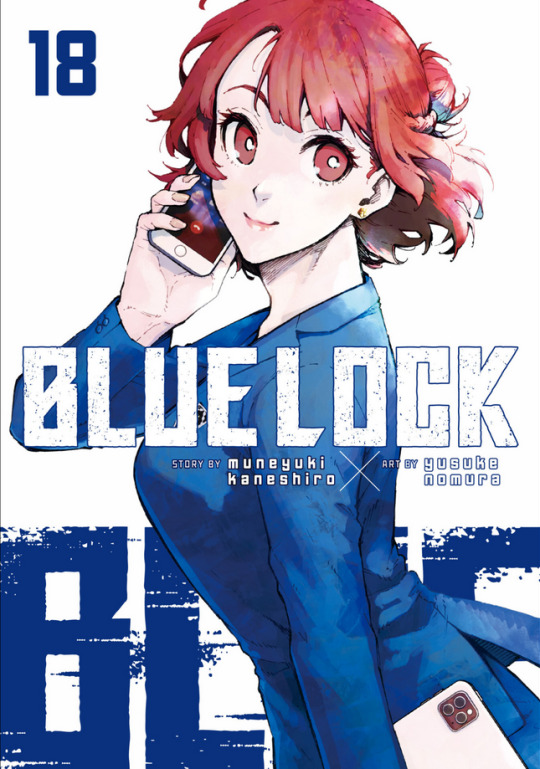


Volume 18: Teieri Anri
Anri is the only character depicted without chains or a collar. While working with Ego is a prison sentence in its own right, the artwork suggests that her ambition and future isn't connected to the outcome of Blue Lock. It can also be interpreted as a nod to the hierarchy within Blue Lock. Anri is Ego's boss and thus, she is free while he is constrained. However...
Zoom in on the reflection on her phone screen. It appears to reflect a wide grin—which can only be one person's. Taking into account her passivity in chapter 247, this detail positions Anri as Ego's accomplice: willing to do his bidding, no matter how amoral.
Volume 19: Michael Kaiser
Kaiser's collar and chains are made of glass, through which his blue rose tattoo is visible. As chapter 243 told us, a blue rose represents the impossible to Kaiser. Glass chains suggests that his ego or ties to football are fragile, and could be broken easily. Symbolically, glass can also represent transparency. As a character, Kaiser is upfront about his talent and desires. Nobody is in doubt about his footballing mantra or his intent to undermine Isagi.
Volume 20: Alexis Ness
Ness's chains are entwined with blue rose brambles, all but for a short length to the top right of the image. While Ness came to love football independently, seeing it as magical, the rose brambles show that his connection to football is now inseparable from his devotion to Kaiser. It also reflects that Ness would not be a professional footballer without Kaiser, as per chapter 242/243.
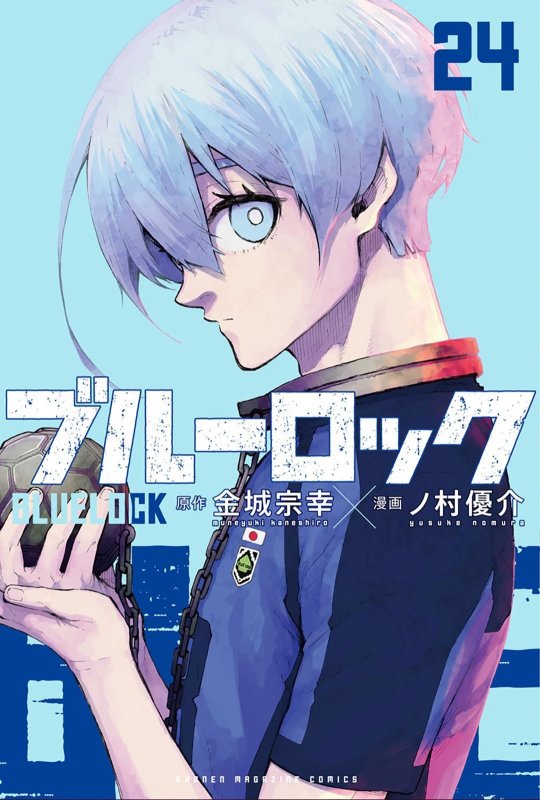
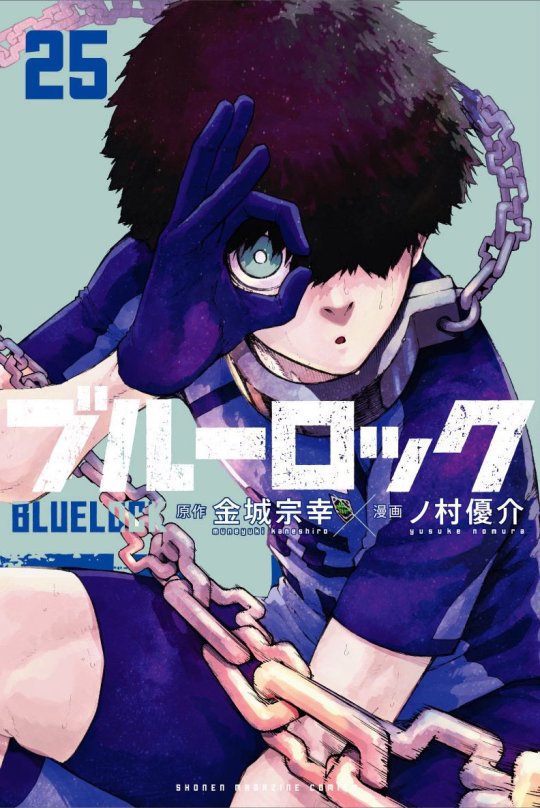
Volume 24: Hiori Yo
Hiori is the only character shown holding the end of his chain, which is secured by a football-shaped weight. This suggests that Hiori himself is the one in control of his career, rather than external forces. Football is a burden to him, albeit something he can carry. Therefore, Hiori is not ensnared by the chains (or Blue Lock) to the same extent as other characters. Appropriate for a character guaranteed to succeed as a footballer, but who ultimately may not choose to pursue it.
Volume 25: Niko Ikki
Niko's volume cover is hilarious. I'll leave the explaining to Tomo-tan, who lays out the humour and genius of Niko's cover in this great Reddit post.


Volume 26: Don Lorenzo
Members of the New Generation World XI have no chill when it comes to their covers, and Don Lorenzo is no exception. His collar shows bite marks, as though chewed through. Gold teeth are good for more than caramel popcorn, apparently.
Lorenzo's chains are accompanied by what looks like electricity. This suggests that football reanimated Lorenzo from near death, as per chapter 216. It's a visual nod to his playstyle, which resembles the incessant pursuit of a zombie. Guess we can call him Snuffy's Monster.
Volume 27: Sendou Shuuto
A blue glow appears on Sendou’s chains, halted from travelling further by his fist. This may represent the threat Blue Lock poses to Sendou's footballing career. He's already been kicked as the striker of the national team; now in the Neo Egoist League, he must battle for a place on the new U20 line-up. No easy feat, as his sweaty face implies.
Another detail worth mentioning is that the trajectory of one of Sendou's chains appear to align with the chain Aiku's pulling in his cover. This similarity, and the fact that they're both holding their chains, may be interpreted as a nod to their status as former U20 teammates—likely the only ones that will make the new team, going off the latest NEL auction table.



Volume 29: Nanase Nijiro
Debated adding him, but eh—I wrote up Reo's cover. Nanase's illustration (incl. the chains) is shaded green… similar to Rin's eyes and aura colour. His chain jerks right and left in a nod to his ambidexterity.
Volume 30: Tsurugi Zantetsu
Another gag cover on par with Niko's, albeit less clever (intentionally?). Zantetsu's chain is made of shapes you'd associate with a toddler's learning shapes toy.
Volume 31: Charles Chevalier
Charles's cover is a double whammy. He gets two colours like Aiku, reflecting his capricious nature. Gold and metallic are representative of his high worth. The background spirals are a definite nod to the Cheshire Cat, a character Charles states he likes in an end of volume character profile.
The chains are shaped like the devil emojis that appear in Charles's dialogue. The chains also feature two materials: an alternating light and dark metal with no evident pattern. This perhaps represents the way his passes are hit or miss, or the way he decides who to send passes to on a whim.
#I'd love to see what people think#also hit me up if you think I missed something in another cover#blue lock#bllk#blue lock analysis#bllk analysis#blue lock meta#bllk meta#blue lock anime spoilers#boinin talks bllk#long post#mine#mikage reo#tokimitsu aoshi#ego jinpachi#shidou ryusei#aiku oliver#itoshi sae#teieri anri#michael kaiser#alexis ness#hiori yo#niko ikki#don lorenzo#sendo shuto#nanase nijiro#tsurugi zantetsu#charles chevalier#updated: 1 October
285 notes
·
View notes
Text
the bedroom hymns ● chapter list
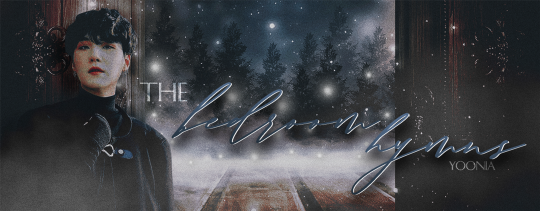
⟶ Title | The Bedroom Hymns: a Bluebeard’s twist ⟶ Summary | A threat against your father’s empire has forced him to send you away from the only place you have known to be your home, from the heaven-like prison which you have always dreamed about escaping, only to find yourself in a new kind of confinement. Haunted by the questions about your father’s past and the dark tales that seem to follow him, the thousand mysterious doors and the secrets waiting for you to reveal, and the mysterious Prince that has been following your shadows between realms, you are off to a new adventure in the Land Far Far Away.

⟶ Pairings | Min Yoongi x female reader ⟶ Genre | Fairy Prince!Yoongi, Princess!reader, Fantasy au, Fairy Tale retelling au, Faerie au, Angst, Mystery, Smut ⟶ Ratings & Warnings | +18 / M for Mature; this story contains classism, threats of assassination, curses, dark magic, rumours about serial killers, mentions of abductions, mentions of arranged marriages, betrayal, manipulation, depiction of war, fantasy typical violence, mentions of blood and wounds, minor descriptions/depictions of injuries, fantasy weapons (swords, etc), mentions/depictions of death, mentions/depictions of domestic abuse, alcohol use, mentions/depictions of plagues/illness — also includes mature and explicit sexual scenes (...more details will be added as I continue writing this piece...) ⟶ Status / Current word count / Total word count | ONGOING; latest update: chapter xxiii. serendipity-3 (Sept 9th, 2024) - 192,000 words of n/a words ⟶ Main Masterlist | Mailbox | Taglist | Feedback | Music Playlist | Ko-fi

𝕺𝖓𝖈𝖊 𝖚𝖕𝖔𝖓 𝖆 𝖙𝖎𝖒𝖊, 𝖎𝖓 𝖙𝖍𝖊 𝖑𝖆𝖓𝖉 𝖔𝖋 𝕱𝖆𝖗 𝕱𝖆𝖗 𝕬𝖜𝖆𝖞…
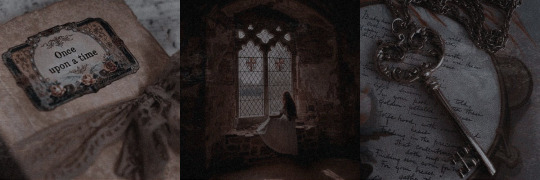
⏤ Written by @yoonia for the Once Upon A Fantasy collab; with @jamaisjoons, @yeoldontknow, @inkedtae, @opaljm, @kookdiaries, @kth1fics
⏤ Crossposted on: AO3, Wattpad

⟶ Chapters
⇢ prologue. the bluebeard’s tale
⇢ chapter i. when the stars are aligned
⇢ chapter ii. the wicked king
⇢ chapter iii. dreamers
⇢ chapter iv. in bloom
⇢ chapter v. homecoming
⇢ chapter vi. the castle by the sea
⇢ chapter vii. the secret doors
⇢ chapter viii. chasing shadows
⇢ chapter ix. secrets
⇢ chapter x. wanderers-1
⇢ chapter xi. wanderers-2
⇢ chapter xii. alias
⇢ chapter xiii. red strings-1
⇢ chapter xiv. red strings-2
⇢ chapter xv. crescendo
⇢ chapter xvi. respite
⇢ chapter xvii. divulgence
⇢ chapter xviii. the fairy prince
⇢ chapter xix. visions
⇢ chapter xx. traces
⇢ chapter xxi. serendipity-1
⇢ chapter xxii. serendipity-2
⇢ chapter xxiii. serendipity-3
⇢ chapter xxiv. serendipity-4
⇢ chapter xxv. masquerade
⇢ chapter xxvi. the golden door
⇢ chapter xxvii. the king’s secrets
⇢ (...more chapters coming soon...)

⟶ References, Feedback, & DIscourse
⇢ visual references ⇢ story feedback & theories

⟶ Patreon specials
⇢ visual moodboard

— © Yoonia, all rights reserved. reposting/modifying of any kind is not allowed. unsolicited translations are not allowed.
#bangtansorciere#kvanity#btscreaturescoven#misc: fic index#yoongi smut#yoongi scenario#yoongi fanfic#yoongi fluff#yoongi angst#suga scenario#suga fanfic#suga smut#suga angst#suga fluff#yoongi x reader#suga x reader#bts scenario#bts fanfic#kpop scenario#kpop writing#kpop fanfic#bts smut#bts fluff#bts angst#bts x reader
738 notes
·
View notes
Note
what's your general interpretation of yume nikki?
I think a lot of Yume Nikki is intentionally left up to interpretation, with a lot of its character and world designs being akin to stuff the creator just thought was neat or interesting to look at. I think if there is a clear theme throughout the game, it's isolation/lonliness.
It's pretty clear from the beginning that Madotsuki refuses to leave her room. When you interact with the door, it's not like you hear a locked door sound or anything, she just shakes her head "no". It's also one of the only things in the game she physically responds to.
Also her name Madotsuki, which to my knowledge isn't a normal Japanese name, translates roughly to "window" or "windowed". I'm not 100% sure if that's accurate but it kind of brings to mind the idea of always being on the outside looking in. That one famous part where you watch a party from the bushes kind of highlights this.
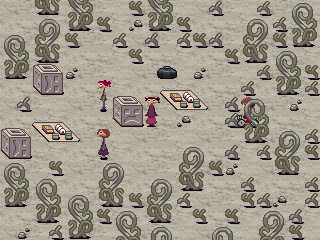
In the dream world, every NPC either ignores you or runs away from you. One of my favorite examples of this is in the mall. It's one of the only areas in the game with a large population of "normal" humans at once, and when you try to interact with them, they become distorted and start avoiding you.
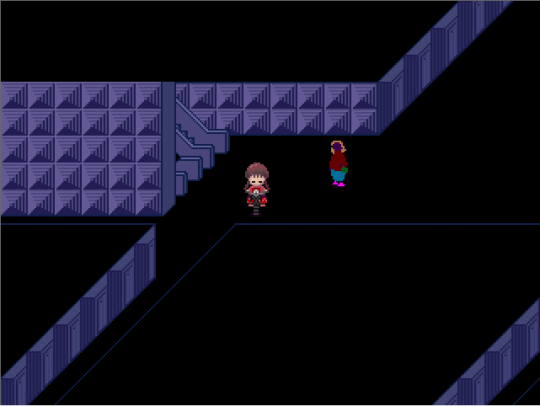
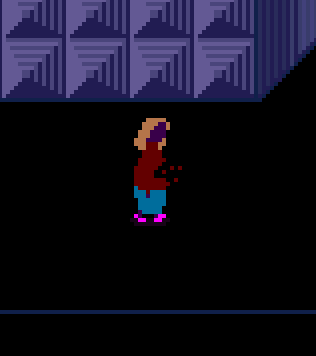
I've seen people speculate that Madotsuki has some dark shit from her past involving potentially knifing someone (hence the knife effect and the other gorey imagery) but I don't really buy that. The """official""" Yume Nikki manga hints at Madotsuki potentially murdering someone but it's just a bit too cheesy for me to believe.
To me it's more interesting to think it represents her fear of resorting to some sort of violence due to her loneliness/isolation. Or she just likes gruesome/macabre things.
Back on the topic of isolation/loneliness, I think the most interesting aspect of this is her interaction with certain NPCs. Madotsuki is (presumably) a young girl, so she would probably relate the most to other girls. But every interaction with the "normal" girls in her dreams is bizarre.

Let's take the Toriningen for example. They're the closest things to "enemies" in the game, given that they take you to small prison-like areas when they catch you. They're clearly designed to resemble human girls except for their bird-like faces. I really like the theory that they represent popular girls, or other peers of Madotsuki that she's intimidated by (hence their height, they're possibly older than her or its symbolic.) They could even be bullies, sometimes hostile towards her or sometimes not.
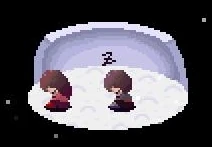
There's Kamakurako in the igloo, who just ignores Madotsuki completely.
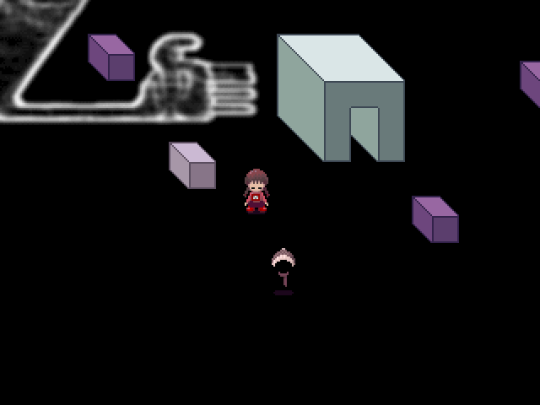
Mafurako (who appears as a normal looking girl if you use the stoplight) will teleport you away if you try to interact with her. Possibly her shunning Madotsuki or Madotsuki keeping her distance.

Monoe is an interesting example because she's the only character that calls attention to herself by displaying a full-sized portrait when you try to interact with her. I find this really interesting why this character is given so much attention, and similar Mafurako she teleports herself away. Another example of Madotsuki not being able to interact with another girl.
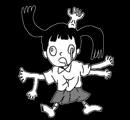
Not sure what's going on with Monoko. Similar to Monoe, she draws attention to herself by having a full-screen event. Maybe Madotsuki can't relate to her, or is disgusted by her for some reason.

Poniko is definitely the most interesting example of this recurring theme of Madotsuki's weird interactions with her peers. Like other characters, she ignores you completely. Her bedroom is also possibly the most normal looking area in the game, implying that it's someplace Madotsuki has been many times. Maybe a childhood friend?
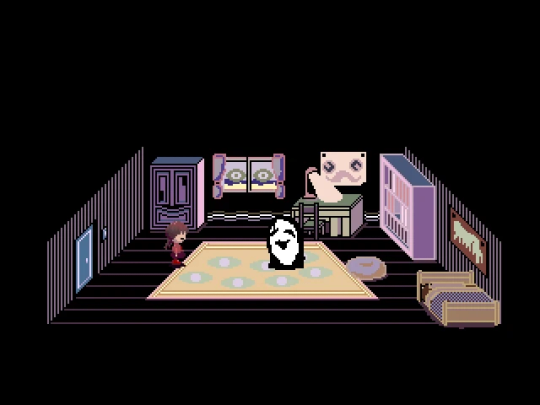
One aspect of the Uboa event I don't see people talk about a lot is how her bedroom changes when the event is triggered. The sudden visual motif of eyes (and googly eyes) is very reminiscent of other areas of Madotsuki's dream. I like to imagine this is Madotsuki's mind "infecting" the memory of this room, and in turn changing her perspective of her old friend(?) into this strange monster. I'm not sure what exactly Uboa is supposed to represent, but I think it's more about Madotsuki's memories with Poniko being tampered by her own fears or insecurities.
There's a lot more you could unpack in Yume Nikki, such as the possible themes of sexual abuse, traffic accidents, violence, gender identity... but this is my personal guess as what the "true" meaning of the game is.
I still think Kikiyama didn't ever have a specific story in mind for the game and it is more of an interpretive art piece, but this is my personal guess to what Yume Nikki is about.
Even I think this analysis is pretty surface level, so that's why I enjoy the different theories regarding this game. The ones about gender identity is really interesting to me.
66 notes
·
View notes